Eucalyptus viminalis



Fibrous or Flaky
Fibrous bark is thickish (thread-like) forming a dense cover. Flaky bark falls away in small pieces or in long strips.
Narrow domed
A tree or shrub with a narrow rounded outline.This variable large tree has a straight trunk with rough brown bark at the base that shreds in ribbons to reveal smooth white drooping branches. It has dull green lanced-shaped leaves and the cream flowers appear in a cluster during summer.
Eucalyptus viminalis Labill. is naturally found from south-eastern New South Wales to Victoria, Tasmania and King and Flinders Islands. It grows on the foothills of the Great Dividing Range and coastal regions from sea level to an altitude of 1,300 m (4.265 ft) and appears in tall open Eucalypt forests or woodlands, heathlands and cleared land. It prefers a well drained sandy to alluvial or loamy soil with a clay base that is acidic with a pH range from 5.5 to 7.5. It grows in a open to exposed sunny position with an annual rainfall between 500-1,700 mm and is frost-cold and drought tolerant but dislikes waterlogged or saline soil.
Manna Gum is a large tree that is grown for its stately habit and rounded crown. It is planted in parks and large gardens as a lawn specimen for shade. It is also used in roadside plantings and in open plains on farms where it is used as a shelterbelt or as a shade tree for stock. The timber is not durable but it is used in framing and flooring and the tree is fast growing when young, establishing in 2 to 4 years. It is very hardy and long lived and re-shoots after low intensity fire. It is also a favourite tree for koala as the leaves are high in nutrients and low in toxins. It can be planted along water courses for erosion control and the flowers produce nectar for honey production. Once established it has a low water requirement (Scale: 1-drop from 3), preferring organic rich reliably moist deep soil but will tolerate dry periods.
I.D. 638
UK hardiness zone H3
Climate zones 5, 6, 8 - 24
USDA Zone 7-11
Eucalyptus (ew-ka-LIP-tus) viminalis (vee-mi-NAH-lis)
Etymology
Genus:- Greek - Eucalyptus– derived from ‘eu’ well and ‘kalyptos’ – covered – referring to the operculum of the flower bud
Species: Latin – viminalis – viminous, or osier-bearing
subsp. cygnetensis
This tree grows to 20 m (66 ft) tall and is found in south-western Victoria, east of Melbourne growing in well drained poor-moderately fertile sandy soils commonly along creeks. It is found at low altitudes up to 150 m (492 ft) and tolerates frost, drought and salt laden winds.
subsp. pryoriana
This tree grows to 20 m (66 ft) tall and is found in southern Victoria and extends to south-east South Australia growing in well drained poor-moderately fertile sandy soils in coastal positions. It is found at low altitudes up to 460 m (1,509 ft) in exposed positions and tolerates frost, drought and salt laden winds.

Australia (south-eastern New South Wales, Victoria, Tasmania, King Island, Flinders Island)
Myrtaceae (mir-TAY-see-ee)
Myrtle, Eucalyptus, Clove and Guava Family
This is a large family of shrubs, mallee and trees with showy stamens and peeling bark. It has a large representation in the Australian landscape.
Distribution
The plants in this family are predominantly found in the southern Hemisphere with 75 genera native to Australia and the remaining distributed in South America, Africa and the neighbouring islands. They are located in tropical rainforests, sclerophyll, heaths and woodlands in rich to poor dry soils.
Diagnostic Features
The simple leaves are normally opposite; occasionally spirally arranged with no stipules and normally an entire margin. There are pellucid oil glands dotted on the leaf, which may be obscured and when the leaf is crushed it is aromatic.
The juvenile, intermediate and adult leaves may be different in arrangement and shape on the same plant.
The regular flowers are hermaphrodite or sometimes unisexual and may be axillary, solitary, or arranged in cymes, umbles, terminal spikes, racemes or panicles. The floral tube covers the ovary and may continue above the ovary summit and form a disk around the ovary.
There are 4 to 5 sepals and petals normally fused to form a calyptra or are free.
The stamens are five to many and may be free or fused into 5-bundles that are opposite the petals.
They have an inferior to semi-inferior ovary that has 1 to 10 carpels, normally five with 1 to many ovules that are inserted on an axil that is basal or rarely a parietal placenta.
The style ends with a narrow stigma and the anthers normally open with longitudinal slits or pores.
The fruit may be a capsule, berry, nut or drupe-like with the cup that surrounds the ovary that is fleshy or dry and woody.
The seed may vary in structure and the cotyledons may be small or large.
Note:
This family has many attractive species and are extensively used in ornamental. Eucalyptus, Melaleuca, Callistemon and Thryptomrnes are just some of the plants represented and they are normally pollinated by insects, birds and in some cases by mammals.
This plant tolerates between USDA zones 7a to 11a and grows to 70 m (229 ft)
Fahrenheit 5º to 45º F
These temperatures represent the lowest average.
Celsius -15º to 7.2º C
Attention
This plant was last revised on the 24/8/2020
All photographs and data are covered by copyright. Apart from any fair dealing for the purpose of private study, research, reference or review, as permitted under the Copyright Act, no part including images and text may be reproduced by any means without written permission. The information presented in the map is only indicative and may contain errors and omissions. All inquiries should be addressed to sales@plantfile.com attention Peter Kirkland.

Simple
The leaf that is not divided.
Lanceolate
Broadest at the centre, three or more times long as broad (Lance-shape).
Alternate
Leaves are arranged alternately along the stem.
Entire
A leaf margin with no irregularities (smooth).The oppositely arranged juvenile leaves are sessile and broad lanceolate up to 150 mm (6 in) long by 35 mm (1 3/8 in) wide. The alternately arranged dull green narrow lanceolate adult leaves are petiolate and concolorous, up to 200 mm (7 ¾ in) long by20 mm (¾ in) wide.
Note: This tree is heterophyllous (having more than one leaf type) commonly with a marked difference between juvenile, intermediate and adult leaves.

Campanulate
A flower forming a bell shape, (rounded base gradually enlarged) petals may be fused or absent (Eucalyptus species).
Umbellaster
A unique umbel-like inflorescence structure where the buds originate from one growing point and splits into two growing points followed by these two splitting into two more, etc and so on. Normally found on Eucalyptus and Corymbia species.| Jan | Feb | Mar | Apr | May | Jun |
| Jul | Aug | Sep | Oct | Nov | Dec |
There are 3 to 7 white flowers arranged in a umbellaster with flattened peduncles and the pedicles absent. They appear from summer to autumn and the 10 mm (3/8 in) long by 5 mm (1/8 in) wide buds are ovoid and the opercula is conical to hemispherical-apiculate.

Capsule
A dried dehiscent fruit, with an enclosing membrane normally containing may seeds."Manna Gum is a large tree that is grown for its stately habit and rounded crown. It is planted in parks and large gardens as a lawn specimen for shade. It is also used in roadside plantings and in open plains on farms where it is used as a shelterbelt or as a shade tree for stock. The timber is not durable but it is used in framing and flooring and the tree is fast growing when young, establishing in 2 to 4 years.
It is very hardy and long lived and re-shoots after low intensity fire. It is also a favourite tree for koala as the leaves are high in nutrients and low in toxins. It can be planted along water courses for erosion control and the flowers produce nectar for honey production.
Note:
It is not suitable for urban gardens due to its size. Care should be taken when selecting a site, allowing ample room for it to grow as it has vigorous invasive roots that can lift concrete and block drains.
Pests and Diseases
This plant is resistant to Phytophthora cinnamomi.
Eucalyptus and Corymbia species are attacked from a wide range of pests and diseases. A healthy tree normally responds to attack with no long term problems. Trees that are under stress or in poor health tend to attract pests and diseases, commonly resulting in the death of the plant.
Generally the following pests and diseases may be found on these trees;
Apple Root Borer, Auger Beetle, Brown Eucalypt Beetle, Christmas Beetle, Cicadas, Coccid Galls, Common Froghopper
Common Jassid, Cottonycushion Scale, Cup Moth, Dieback Borer, Dodders, Elephant Weevil, Emperor Gum Moth
Eucalyptus Leaf Beetles, Eucalyptus lerp, Eucalyptus Sawfly, Eucalyptus Shoot Blight, Fergusonina Galls
Flower Scarab Beetle, Fruit Tree Borer, Giant Longicorn, Green Gum Tree Hopper, Gumleaf Skeletoniser, Gumtree Scale
Honey Fungi, Jewel Beetles Leafblister Sawflies, Mistletoe, Nectar Scarabs, Pimple Gall, Steelblue Sawfly, Termites, Tip Bug
Soldier Beetles and the White Stemmed Gum Moth.
General pruning information
Eucalyptus species require little pruning apart from removal of damaged or dead wood, which should be taken off at the collar. If the tree is cut back hard it will produce epicormic shoots and the crown may be lifted or thinned by removal of selected branches.
Surface sow fresh seed during spring in a well-drained media, and maintain a temperature of 16º to 18º C. (61º to 64º F). Prick out and pot up when they are large enough to handle then grow on before planting out. Note: Eucalyptus and Corymbia species are fast-growing and should be planted when the young in order to establish a strong root system.
Propagation by Seed (General)
Germination
In order for a seed to germinate it must fulfil three conditions.
1. The embryo must be alive (a viable seed).
2. The seed must have no dormancy-inducing physiological, physical or chemical barrier to germination; also the seed must be non-dormant.
3. The seed must have the appropriate environmental requirements, water, temperature and oxygen.
The interaction between these requirements and dormancy is complex and may lead to different environmental requirements that avoid the dormancy of a seed.
Sowing Seeds in Containers
There are two general methods for germinating seeds.
Seeds in a flat or germinating bed, through which seedlings are pricked-out then, transplanted into another flat with wider spacing or directly to an individual pot.
2. Sowing seeds by placing them in to flats with the appropriate spacing or into individual pots.
This method is normally carried out with medium to large seeds such as woody plants and plants that are difficult to transplant.
Seedling production normally occurs in a greenhouse / glasshouse, cold frames and on hot beds.
Method of Seed Sowing
Fine seed is sown in pots or flats that are no deeper than 70 to 80 mm. using a sterilised well-drained media (soil). Fill the container to 20 mm from the top and sprinkle sieved peat to 3 mm depth.
Press the media down level and firm with a piece of timber and then thoroughly moisten.
Mix the fine seed with washed sand and then sow thinly on the surface. These may be lightly covered with sand.
Larger seeds may be covered with media or a hole is dibbled and the seed is placed in the media.
Watering Methods
For watering you may either mist the containers from above or place the container in tepid water and allow the water to raise through the pot to the surface of the media, then drain away and do not fill to the top of the container.
Place a piece of glass over the pot and store in a protected warm environment (glasshouse).
Seeds germinate best in darkness so shade the containers if in direct sunlight.
After the seedlings have sprouted remove the glass and ease the seedlings into direct light.
When the seedlings are large enough prick them out and transplant into larger containers then place them in a shade house to harden off.
Many seeds have different methods of seed preparation for germination such as nicking or cutting the seed coat to allow water penetration, also placing seeds in hot water and allowing it to cool off.
This is particularly important as it is softening the seed coat.
PEST
NAME
Borer (General)
Various Borer Species
ORDER
Various
FAMILY
Various
Description of the Pest
Generally the larvae bore holes into the heartwood, sapwood or down the centre of twigs. These tunnels may be small or large, deep or shallow and when they emerge from their tunnels at night, they feed on the surrounding tissue. Entrance holes may be covered by a layer of chewed wood fragments ("frass"), silk webbing or exposed and the tunnels may be solitary or form galleries. Certain species attack only twigs and young shoots, while others attack the trunk or roots.
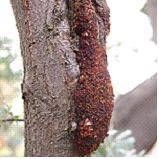 Fruit tree moth borer damage
Fruit tree moth borer damage
The adults female of a fruit tree moth borer normally deposits eggs in damaged areas of the bark or where there is and existing active site. The larvae vary but generally they are creamy to brown, thick soft grub-like reddish brown, and up to 40mm in length.
The adults are white, satiny moths with 40-60mm wingspans with their black abdomens fringed with orange-brown hair or beetle lava that has been deposited in the bark or twigs then tunnels the host.
American Plum Borer (Euzophera semifuneralis) lava is pinkish white to brownish green and attacks the inner bark and cambium region of the tree causing premature death. It is normally found on Platanus orFraxinus species and may also infest many species of fruit trees.
Apple Root Borer (Leptopius squalidus) female adult is a weevil to 20mm long and feeds on the leaves and the plump, legless grub-like lava feeds on the roots of the same host forming tunnels in the deep roots. It is commonly found on Acacia and Eucalyptus species damaging the anchorage of the plant.
Banksia Borer (Cyria imperialis) adult is a black beetle with yellow markings on its wing covers growing to 15mm long. The thickish legless lava is white, tapering from the head and forms flattened tunnels into the heartwood of the host.
Bronze Birch Borer (Agrilus anxius) is a bronze coloured beetle up to 14mm long and lays eggs in crevices in the bark. The legless white larva grows to 20mm long and feeds on the sapwood girdling the branch with flat irregular galleries.
Cedar Tree Borer (Semanotus ligneus) is a black beetle with orange and red markings on its wing covers and grows to 12mm long. The larva feeds on the sapwood of Sequoia, Thuja species and Pinus radiata with curved tunnels that may girdle branches.
Chestnut Borer (Agrilus bilineatus) adult is a tiny slender, blackish green beetle up to 8mm long emerging during spring. The small white larvae have a flat head and are up to 15mm long, forming galleries under the bark of Quercus species.
Cypress Bark Beetle (Phloeosinus cupressi) adult is dark brown with a blackish head, oblong in shape up to 3mm long. The tiny beetles tunnels under the bark of the host and deposits eggs. After hatching the tiny 4mm long, legless larvae bore into the heartwood damaging the tree. After they pupate in the tunnel they emerge through small round holes, commonly many together on the trunk. Damaged trees show signs of browning and dead leaves in the upper branches or falling damage twigs. Cupressus species are particularly vulnerable to attack.
Deodar Weevil (Pissodes nemorensis) is brownish with an obvious snout feeding on the cambium layer and deposits eggs in the bark of the leader and branches. The white lava tunnel the wood eventually killing the leader.
European Corn Borer (Pyrausta nubilalis) is a small moth that lays up to twenty eggs on flower buds. The young flesh coloured larvae mature to a reddish brown and each of its segment has four, spined dark spots.
Elephant Weevil (Orthorhinus cylindrirostris) is a grey or black insect up to 20mm long and lays eggs in the bark near the base of stressed trees. The larva tunnels its way through roots or trunks depositing frass as it goes, then emerging from a second round hole. The adults eat strips from the leaves, normally not bothering the plant.
Elm Borer (Saperda tridentate) adult is a greyish beetle with red bands and black spots on its wing covers and is up to 12mm long. The eggs are laid on the bark and the whitish lava tunnels into the bark and sapwood where it overwinters. It is normally found on Ulmus species.
Iris Borer (Macronoctua onusta) is born from a grey moth with a wing span up to 30mm across, and lays eggs that overwinter in old leaves and debris. As the leaves emerge the eggs hatch entering the leaves at the base, visually forming tunnels and growing to 30mm long. In the later season flower buds may be attacked. Both flowers and leaves eventually turn brown and die.
Lilac Borer (Podosesia syringae) adult is a wasp-like moth that produces pure white lava with a brown head that are up to 25mm long. It initially feeds in the sapwood causing wilting before tunnelling the hardwood making the branches brittle. Evidence of frass is found at the tunnel entrance and secondary fungal attacks infect the holes. Normally found on Syringa species.
Locust Borer (megacyllene robiniae) adult is a black beetle with golden spots, up to 20mm long and produces a small larva that tunnels galleries into the sapwood causing a blackish discolouration. Robinia species are normally attacked.
Mottled Borer (Cryptorhynchus lapathi) attacks Salix species. The adult beetle is black up to 10mm long and the lava bore into the surface of the stem causing swollen growth. Salix species are attacked.
Murry Pine Borer can be two species (Diaoxus erythrurus) and (Diaoxus scalaris). The adults are glossy green-brown beetles that are up to 20mm long and the white grub-like lava is legless, tapering from the head. They tunnel into the sap or hardwood of the trees forming connecting galleries causing ringbarking and creating brittle branches, commonly fond on Callitris species.
Peach Borer (Sanninoidea exitiosa) is a larva that tunnels roots causing gummosis that is mixed with frass at the crown just below soil level. The affected Prunus species produce yellowish leaves and grows poorly. There is another borer, Lesser Peach Borer (Synanthedon pictipes) which attacks any part of the plant from the trunk to the branches and is found on several Prunus species.
Puriri Moth (Aenetus Virescens) a New Zealand short lived moth that grows with a wing span of over 100mm (4in) wide laying eggs on the forest floor at night during spring. The caterpillars grow to 100mm long feeding on leaves and then ascending into the trees and entering the cambium layer up to 150mm deep forming a characteristic '7'-shape burrow that is concealed by frass. The caterpillar may live for 7-years before pupating and collectively they ring bark branches or trunks causing dieback.
Many New Zealand plants including Nothofagus solandri, Pomaderris spp.and ornamentals such as Quercus spp. Betula pendula, Salix spp. Populus spp. Acer spp. Citrus limon and Paulownia spp. are attacked. Control is difficult and generally the plants tolerate attack.
White Pine Weevil (Pissodes strobi) lava feed on the inner bark and sap wood of terminal shoots causing ringbarking and death of the shoot. The reddish brown beetle up to 6mm long is mottled in white and emerges during early summer then lays yellowish lava that are up to 9mm long.
Scribble Moth (Ogmorgraptis scribula) is a grey moth up to 0.4mm wide and produces a cream to brown larvae that is also about 0.4mm long and tunnels in the bark causing a scribble effect. This normally has no detrimental effect on the tree.
Spotted Hemlock Borer (Melanophila fulvoguttata) adult is a colourful metallic beetle with yellowish red spots on the wing covers and lays eggs in cracks in the bark. The white lava is up to 14mm long and forms galleries in the bark and sapwood of the host.
The large Swift Moth and Wood Moths can have a wing span up to 250mm wide and produce large larva that are grub like up to 150mm long, some with horny plates on the thorax. These larvae bore tunnels that are up to 30mm across straight through the heartwood of the host plant. The larvae may live in the tunnel for up to five years before pupating.
Red Cedar Bark Beetle (Phloesinus dentatus) is a small beetle up to 3mm long and lays its larva in excavations in the bark. When the larva emerges they bore galleries in the bark and tend to be more prevalent in stressed or recently transplanted plants.
Vegetable Weevil (Listroderes difficilis) is found during cooler weather (spring or autumn). The adult brown beetle up to 19mm long with a "V" mark on its back and the eggs are laid in the soil around the base of the host plant. The cream coloured lava emerges in spring after rain and feed on the lower leaves forming irregular holes or chewing holes in stems. The lava also feed on fleshy roots boring holes into carrots. Both the adults and lava cause damage, feeding on the plant during the night and resting at the base or under ground during the day. The lava pupates in the soil over winter.
Wattle Web-covering Borer (Cryptophasa rubescens) adult is a satin coloured moth that is up to 50mm across and deposits green fleshy lava that is up to 35mm long. The lava forms shallow tunnels in the bark and sap wood of the host and camouflages it with chewed wood and faeces that is webbed together. Commonly seen attacking the branches on Acacia species.
Life Cycle
These insects have normally have a Holometabolous life cycle. But some borers such as Termites have a Hemimetabolous life cycle.
Eggs are laid singly or in groups, in damaged areas of the bark and branch. Larvae shelter in tunnels they create in the wood and some species may take many years to pupate and emerge as an adult. This may take place in live or dead wood. Other species such as Corn Borer can have up to two generations per year.
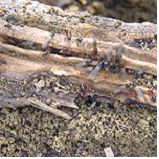 Termites and their damage
Termites and their damage
Distribution of the Pest
Borers are found throughout the world with many species found in Australia both on the coast and inland.
Period of Activity
Varies with the insect concern. Many larvae can be active for many months. Termites are active all year.
Damage Caused
Most damage appears on branches or trunks where the larvae feed on the soft tissue and extensive feeding may cause ring-barking. Normally plants survive borer attack but repetitive attack will cause the death. Certain species are a serious pest in plantations or monocultures such as the Pine Bark Weevil, and the Sirex wood wasp.
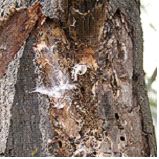 Typical borer damage by a moth larva
Typical borer damage by a moth larva
Chestnut Borer feeds on the sap wood ringbarking large branches and overwinters in the tunnels.
Corn Borer feeds on flower buds and leaves resulting in there death, after which the larva tunnel down the stem causing wilting. There are many crop plants and ornamentals that are affected by this larva.
Swift Moth and Wood Moths weaken trees by boring large tunnels through the branches that may not be noticed until holes are cut through the bark during emergence.
Iris Borer damages leaves to turn brown and wilt, flowers also turn brown and with the aid of a bacterial rot, collapse and die. This damage may be extended to the flower stalk.
Stem Borer (Papaipema nebris) is a small lava to 12mm long, and attacks many garden plants including Lilium, Aster, Alcea and Phlox species
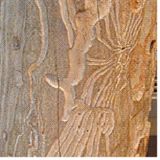 Borer Damage
Borer Damage 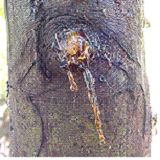 Resin oozing from a trunk
Resin oozing from a trunk
Susceptible Plants
There are many plants that are attacked by these pests including Banksia, Callistemon, Melaleuca, Lagerstroemia, Jacaranda species, and flowering stonefruit. Eucalyptus, Acacia species and many ornamental such as Acer species. Plants that are stressed, are particularly venerable.
Acacia and Eucalyptus species are attacked by Swift Moths and Wood Moths.
Acacia species are susceptible to attack from the Wattle Web-covering Borer (Cryptophasa rubescens), which weakens and causes die back of branches.
Acer platanoides is attacked by the Leaf Stalk Borer (Nepticula albostriella) that tunnels into the petiole of the leaf turning it blackish and also attacks the fruit.
Acer saccharinum is attacked by the Petiole Borer (Caulocampus acericaulis) which tunnels in the petioles. It generally attacks the leaves on the lower branches causing them to fall.
Acer species may also be attacked by several borers including the Flat Headed Borer (Chrysobothris femorata), a 25mm long lava of a coppered coloured beetle, that tunnels galleries under the bark girdling the trees The Sugar Maple Borer (Glycobius speciosus) which girdles branches killing them and the Leopard Moth (Zeuzera pyrina) lava that tunnels large holes into branches making them structurally weak. This lava can grow to 80mm long and 12mm thick overwintering in the tunnels.
Banksia species are attacked by the Banksia Web-covering Borer (Xylorycta strigata) a greenish lava up to 40mm long that tunnels down the centre of branch tips. The entrance is covered in silken web littered with faecal material and causes the death of the branchlets.
Betula and Populus species are attacked with the Bronze Birch Borer (Agrilus anxius) and heavy infestation may kill the tree. Populus species are also attacked by the Poplar Borer (Saperda calcarate).
Brachychiton species are attacked by the Kurrajong Weevil (Axionicus insignis) the lava of this plump greyish weevil is white and legless, entering the plant through wounds forming rounded tunnels that may girdle the tree, killing it.
Carya species are attacked by the Painted Hickory Borer (Megacyllene caryae). The adult dark brown beetle has obvious zig zag lines on its wing covers and the lava is cream coloured, both up to 20mm long. The lava tunnels the sapwood of living trees causing ring barking and also tunnels dead trees.
Cornus species are attacked by several borers such as the Flat Headed Borer (Chrysobothris femorata) and the Dogwood Borer (Thamnosphecia scitula).
Cupressus species are attacked by the Cypress Bark Beetle (Phloeosinus cupressi) causing the branches to turn brown and die off from the top or causing the leaves to wilt. On first indication of infestation selective prune off damaged areas or remove the tree.
Hakea sericea and other Hakea species are attacked by the Web-covering Borer (Neodrepta luteotactella). The larvae bore into the twigs and fruit forming a small covering of frass. This insect also infects Macadamia species. Hakeas are also attacked by several other web-covering borers.
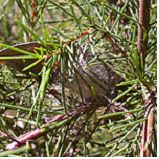 Hakea sericea
Hakea sericea
Pinus and Picea species are attacked by the White Pine Weevil (Pissodes strobi) in the northern hemisphere.
Samanea saman is attacked by the borer (Xystrocera globosa) which chews into the sap wood of stressed trees and can cause serious damage.
Sorbus aucuparia is attacked by the Round Headed Borer (Saperda candida) which forms galleries in the trunk at ground level, forming round holes in the bark.
Tilia species are attacked by the European Bark Borer (Chrysoclista linneela), which feeds on the bark and thew Linden Borer (Saperda vestita) that attacks the base of the trunk or roots.
Tsuga species are attacked by Spotted Hemlock Borer (Melanophila fulvoguttata).
Vaccinium ovatum is infested by the Azalea Stem Borer (Oberea myops). The yellowish lava of this beetle bores into the tips of stems during the flowering period and is up to 12mm (½in) long. It is also commonly found on Rhododenron species.
Control
Cultural Control
Larvae may be destroyed after exposure by pulling away the covering pad of frass, or by pushing a length of wire into the tunnel. Damaged branches may be removed. Improve the culture by feeding and watering the plant.
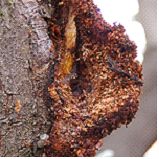 Frass due to the Fruit tree moth borer
Frass due to the Fruit tree moth borer
Biological Control
No effective biological control though certain species of trees exude gum or resin sealing the holes and limiting the activity of the larvae or causing its death.
Chemical Control
There is no satisfactory chemical control most borers of live wood.
Note
It is your responsibility by law to read & follow the directions on the label of any pesticide
PEST
NAME
Coccid Galls
Various Coccid Gall Species
ORDER
Hemiptera
FAMILY
Coccidae
Description of the Pest
Small, sap-sucking insects related to mealy bugs and scale. The feeding of the pale, pinkish-white larvae stimulates the host plant to produce a gall, in which the larvae continue to feed and mature. Different species may have characteristic-shaped galls, and male and females may produce different shaped galls. The adult male emerges as a small fly from the gall via a small tunnel; the female matures and dies without leaving the gall.
These insects have a Hemimetabolous life cycle, ie. When the immature nymphs resemble the adults.
Acorn Gall (Apiomorpha conica) female produces a smooth, roughly oval-shaped gall on the twigs and the smaller horn-shaped galls of the males appear on the leaves.

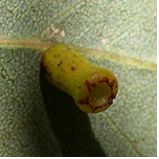 Acorn Gall, Male
Acorn Gall, Male
Four Horned Gall (Apiomorpha munita) female produces a roughly four-sided, four horned gall and the male galls appears in horn-like clusters along the twigs.
Appearance of the Pest
Rounded, cylindrical or horned, woody galls appear singly or in clusters on the leaves and twigs.
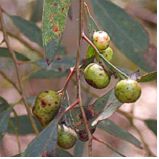
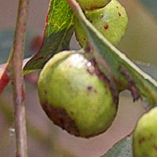 Galls on Eucalyptus
Galls on Eucalyptus
Period of Activity
Galls may appear all year round.
Susceptible Plants
Allocasuarina species are susceptible to the Casuarina Gall (Cylindrococcus species) which contains a single small pinkish sap sucking insect that forms galls with overlapping scales up to 15mm long with an acuminate apex. The galls are very simular looking to the capsules of the plant. This pest may also be found on Casuarina species.
Eucalyptus species are commonly attacked especially in temperate to tropical regions; Casuarina and some Melaleuca species may also be affected.

Turf Grasses are attacked by the Felted Grass Coccid (Antonina graminis). It is also known as the Leaf Mite or Grass-crown Mealybug and forms a small whitish sherical body that has a dark spot (eye) and when crushed releases a purplish fluid.
It is commonly found on Cynodon species (Couch), Pennisetum clandestinum (Kikuyu), Stenotaphrum secundatum (Buffalo) and Digitaria didactyla (Blue Couch).
Damage Caused
The appearance is unusual but not unsightly. No damage is usually caused.
Control
Not usually required.
PEST
NAME
Longicorns, Long Horn Beetles
Various Longicorn Species
ORDER
Coleoptera
FAMILY
Cerambycidae
Description of the Pest
This is a large group of beetles with over 1,000 species that commonly have two long and conspicuous antennae and square shoulders. They may be large or small, dull or brightly coloured beetles. The creamy-white fleshy lava has reduced legs and taper from the thorax. Both the Lava and adult beetle has chewing mouth parts.
These insects have a Holometabolous life cycle, ie. When metamorphosis is observed during the pupal stage.
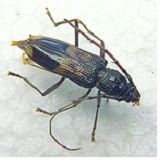
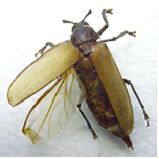
Appearance of the Pest
The adults lay eggs in wounds or in damaged areas by active borer larvae. The Larvae bore large circular tunnels in the sapwood for many months, which become packed with frass. The damage is evident with cracked bark, surrounded by sawdust and the appearance of gum oozing out of the wound.
Some species ringbark twigs or trunks and the larva pupate in the plant.
The adult emerges from 'emergence holes' and may chew bark or foliage but generally the damage is insignificant.
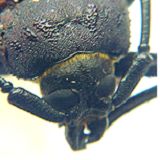
Auger Beetle (Bostrycnopsis jesuita) is another insect that produces a tunnel boring, plump white larva. The adult grows to 18mm long and its thorax forms an outgrowth that extends over its head making the beetle to always look down.
Pittosporum Longicorn (Strongylurus thoracicus) is brown with white spots on either side of the thorax with long antenna and is up to 30mm long. It lays creamy legless lava that feed on the sapwood of small branches in Pittosporum species by forming rounded tunnels.
Twig Girdling Longicorn (Platyomopsis humeralis) is a dark coloured beetle with anatine the same length as its body up to 20mm long. The wing covers may have stripes or dots and the mandibles are strong arranged at right angle to the body. It feeds on bark forming rings around branches or small twigs.
Period of Activity
The adults are active from spring to summer and are found throughout Australia from tropical to temperate regions.
Susceptible Plants
Many ornamental and Australian native trees, shrubs or climbers, including Eucalyptus, Pittosporum, Ficus and Vitis species. The larva also attacks recently fallen timber or existing dead plants.
Banksia species are attacked by the Banksia Longicorn (Paroplites australis) which is a reddish brown beetle to 50mm long with equal length antennae and produces a yellowish fleshy (grub-like) lava, that is legless and tapers towards its tail. It tunnels into the hardwood and can cause severe damage.
Eucalyptus are attacked by the Giant Longicorn (Eurynassa odewahni) which is a large beetle up to 80mm long with equally long antennae and produces a plump legless white (grub-like) lava, that are ribbed and tapers towards its tail.
Grevillea robusta, Melia azedarach and Brachychiton populneus are attacked by the Auger Beetle larva.
Damage Caused
The larva eats away the sapwood and may tunnel deep into the timber creating open wounds on the trunks and in some cases ring barking the plant. Certain species graze only on the bark and associated wood such as The Twig Girdling Longicorn and the result of the damage is not evident well after the insect has moved on. Branches that have been attacked are weakened and snap off during high winds.
The Auger Beetle eats circular holes through the sap wood and heart wood reducing the structural strength of the tree.
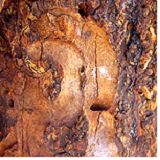
Cultural Control
Stressed plants are commonly attacked and action should be taken to invigorate the plant with additional watering and fertilising. It may be possible to kill the larvae with a piece of wire and areas that have been damaged should be treated with tree surgery techniques to mend the wound.
Biological Control
Beetles and larva are eaten by birds and lizards but are not an effective control.
Chemical Control
There is no effective chemical control.
PEST
NAME
Beetles (General)
Various Beetle Species
ORDER
Coleoptera
Description of the Pest
There are many different types of beetles both adult and larvae feed and have chewing mouth parts.
Agave snout weevil (Scyphophorus acupunctatus)
The Agave snout weevil or sisal weevil is a beetle up to 15mm long. It has a dull brownish-black body with a long protruding snout and chewing mouth parts. The adult female lays eggs at the base of the leaves where the hatching larvae feed on the succulent centre of the leaf with their chewing mouth parts and cause significant damage. Decay microbes then entre through the wounds and cause the plant to die by collapsing from the base.
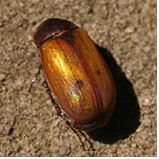
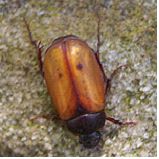 Brown (Scarb) Eucalyptus Beetle
Brown (Scarb) Eucalyptus Beetle
Brown Eucalypt Beetle (Lepidiota rothei) adult is brown with hairy legs and grows to 20mm long. It has chewing mouth parts and feeds on the leaves, sometimes swarming and stripping the host tree. The lava is cream coloured curl-grubs that feed on the roots of the tree. The feeding habits of this beetle are very simular to the Christmas Beetle (Anoplognathus species), eating new shoots and leaves to the mid rib, commonly attacking Eucalyptus species.
European Bark Beetle (Scolytus multistriatus) female adult is reddish up to 3mm long and lays its eggs in tunnels in the sap wood and the emerging lava tunnel through the bark forming tiny holes. This beetle is regarded as a main transmission source for Dutch elm disease that infects Ulmus species.
European Willow Beetle (Plagiodera versicolora) is metallic blue up to 4mm long and overwinters in the bark. During spring the yellowish eggs are laid and the emerging lava skeletonise leaves by feeding on the underside. There can be two generations per year and attack Salix species.
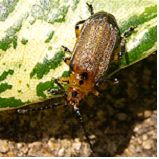 Fig Leaf Beetle
Fig Leaf Beetle 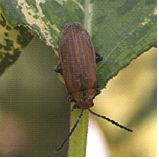
Fig Leaf Beetle (Poneridia semipullata) is a dull brown adult has a reddish brown head and growing to 12mm (¼in) long with prominent antennae. It deposits up to 50 eggs that are in groups on the underside of the leaf. The yellowish spiny larvae are small and appear as sawdust on the leaf. As they mature they turn blackish and grow to 12mm (¼in) long, widest at the head.
It prefers coastal tropical to warm temperate regions and both adult and larvae feed on the leaves. The larva graze in groups skeletonising the leaves and making plants look unsightly.
Figwort Weevils generally the adult beetles are normally black to greyish white, up to 4-5mm long with one or two black circular marks where the wing cases meet. The larvae are yellowish to brown grubs with black heads up to 6mm long and have a slimy texture.
The larvae pupate in spherical cocoons that it spins and is attached to the host stems. The cocoon resembles the seed pods of Scrophularia species (Figwort). Adults overwinter in leaf litter or the soil emerging during spring and lay eggs on the host plant. There is normally two generations per year.
The larvae feed on leaves by grazing the surface of the leaf eating the epidermal layer. The leaf turns brown, shrivels and dies. Many plants are susceptible, including Hibiscus, Dahlia, Vitis species and avocados, potatoes, sweet potatoes, rhubarb, and various weed species.
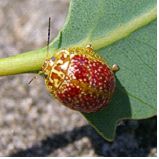
 Paropsis species adult and larvae
Paropsis species adult and larvae 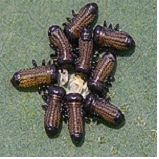
Leaf-eating Beetles in the Chrysomelidae family are found throughout the world with over 3,000 species in Australia. Generally small smooth and colourful, globular or flattened up to 15mm in length with antennae one third the length of the body. Normally adults and larvae feed on the living tissue of the leaves. There are many sub-families including Sagrinae containing the larges species, Bruchinae containing larvae that eat seeds and the larges subfamily Chrysomelinae contains many species such as Paropsis species. These beetles are characteristic dome shape and are commonly seen on Eucalyptus species.
Mountain Pine Beetle (Dendroctonus ponderosae) is a dark brown to blackish adult beetle up to 7.5 mm long. There are 4-larval stages that include a white larval with no legs that appear from vertical egg galleries and mature larval produce oval pupation cells towards the end of the tunnels in the tree. They emerge from small openings at the tunnel end as adults. This pest affects millions of hectares of forest in North America and Canada including many species of Pinus. It normally attacks older weaker trees but under ideal conditions it attacks healthy trees. Pinus albicaulis has become endangered due to the actions of this species. Numerous beetles can attack a single tree and the larval attack on the cambium layer can be accompanied with a fungal attack such as the Blue stain fungi (e.g. Ceratocystsis and Ophiostoma spp.) causing death of the tree. Symptoms include the needles in the crown wilt then turn orange-red for many months then become brown before falling to the ground. Pitch tubes can be located towards the lower part of the tree and consist of frass and resin.
 Staghorn Beetle Damage
Staghorn Beetle Damage
Staghorn Beetle (Halticorcus platyceryi) is a small rounded beetle that is black with four dull red spots on the wing covers. It has pinkish lava and both larvae and adult feed on the epidermal layer of fronds leaving small brownish sunken areas.
Wattle Blight (Paropsis orphana) adult is a light green oval-shaped beetle with white stripes on its wing covers up to 6mm long. The small lava has a tapering shape and both adult and lava feed together in groups on the surface of Acacia species leaves turning them brown.
Vegetable Weevil (Listroderes difficilis) is found during cooler weather (spring or autumn). The adult brown beetle up to 19mm long with a "V" mark on its back and the eggs are laid in the soil around the base of the host plant. The cream coloured lava emerges in spring after rain and feed on the lower leaves forming irregular holes or chewing holes in stems. The lava also feed on fleshy roots boring holes into carrots. Both the adults and lava cause damage, feeding on the plant during the night and resting at the base or under ground during the day. The lavae pupate in the soil over winter.
Life Cycle
This insect has a Holometabolous life cycle, i.e. it has a larval and a pupal stage.
Distribution of the Pest
Beetles are found world wide.
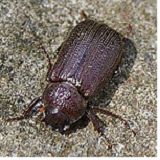
Period of Activity
The beetles are active from spring to mid summer preferring the warmer weather.
Susceptible Plants
The beetles attack many species of trees, shrubs, ferns and small plants as in potted plants in nurseries.
Anemone and Clematis species are attacked by the Black Blister Beetle (Epicauta pennsylvanica) which eats the leaves and flowers.
Callistephus species are attacked by the Asiatic Garden Beetle (Autoserica castanea) that chews on the foliage at night and hides in the soil or around the base of the plant during the day.
Carya species are attacked by the Bark Beetle (Scolytus quadrispinosus). The tiny adult beetle is brown up to 5mm long and the legless lava tunnel the bark and sapwood where it over winters, causing ringbarking. Twigs and small branches wilt and die.
This species is also attacked by the Twig Girdler (Oncideres cingulate), a reddish beetle that is 20mm long and produces small lava that girdles twigs by tunnelling, where it overwinters. This weakens the twigs causing them to snap off or results in ringbarking.
Cheiranthus species may be attacked by the Red Turnip Beetle (Entomoscelis americana) which is bright red with black markings in its head and wing covers and feeds on the foliage.
Eucalyptus species and other plants in the Myrtaceae family are attacked by the Flower Scarab Beetle (Protaetia species) a rounded brownish adult that grows to 20mm long, feeding solitary on flower pollen or new growth causing wilting and twig dieback. The insect is found from tropical to temperate regions and is regarded as a minor pest. Eucalyptus are also attacked by Leaf-eating Beetles which eat irregular pieces from the margins.
 Damaged Margins on Eucalyptus by the Leaf-eating Beetles
Damaged Margins on Eucalyptus by the Leaf-eating Beetles
Protea species are also attacked by the Flower Scarab Beetle.
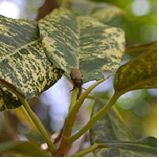 Ficus species
Ficus species 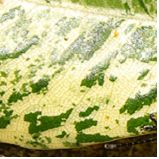 Damaged epidermal layer
Damaged epidermal layer
Ficus species are susceptible to the Fig Leaf Beetle (Poneridia semipullata). Both adult and larvae feed on the leaves eating the epidermal layer and making the plant in large infestations look poorly.
Ulmus species are attacked by the European Bark Beetle and the Leaf Beetle (Galerucella luteola) adult, which eats areas out of new leaves.
Ficus species are susceptible to the Fig Leaf Beetle (Poneridia semipullata). Both adult and larvae feed on the leaves eating the epidermal layer and making the plant in large infestations look poorly.
Samanea saman fruit pods are attacked when the burchid beetle (Merobruchis columbinus) oviposits in the immature fruit. The lava can kill or damage up to 75% of the seeds but is not commonly a major problem.
Solanum tuberosum is attacked by wireworm (Agriotes species). The larvae of this beetle, tunnels into the tubers. It is best controlled by planting in the soil which has not been affected previously.
Ulmus species are attacked by the European Bark Beetle and the Leaf Beetle (Galerucella luteola) adult, which eats areas out of new leaves and its lava skeletonise the underside of mature leaves later in the season.
Damage Caused
Some beetles and their larvae may eat the leaf surface in bands leaving the veins intact while other larger beetles tend to eat leaves from the margins preferring new shoots.
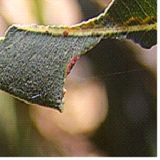 Beetle damage
Beetle damage
Cultural Control
Small infestations may be removal by hand where possible.
The Brown Eucalypt Beetle will not fly during the night and if disturbed by shaking or beating the tree, fall to the ground where they can be collected on a tarp that is laid under the tree then destroyed. This method also works on the Flower Scarab Beetle that fall to the ground pretending to be dead when disturbed.
Biological Control
Beetles are eaten by predators including birds, frogs, and lizards and are attacked by parasitic wasps.
Chemical control
Will vary with the pest, the plant on which it is found. The part of the plant being attacked.
Note
It is your responsibility by law to read & follow the directions on the label of any pesticide
Amendments by B. Sonsie Dip Hort Sc Burnley
PEST
NAME
Christmas Beetle
Anoplognathus Species
ORDER
Coleoptera
FAMILY
Scarabaeidae
Description of the Pest
Christmas beetles are large up to 200mm (¾in) long. The adults have a stout body shape the antennae are flattened into discs. The common species Anoplognathus pallidicollis and Anoplognathus porosus have shiny buffed tan-brown elytra (wing covers) and a metallic green coloured head. Another species (Anoplognathus smaragdinus) are very showy with metallic blue, orange or green colourings. The plump larvae (commonly known as the 'curl grub') are creamy-white in colour with a dark area near the end of the abdomen.


A shiny brown adult that is found in the warmer regions of Australia and is up to 20mm long. This beetle feed on the leaves and when swarming may strip the host tree.
Life Cycle
This insect has a Holometabolous life cycle, i.e. it has a larval and a pupal stage.
The larvae pupate in the soil and the beetles emerge in summer with usually one generation per year.
The larvae can live for up to two years. Adults may live for up to a year, this varies for the species concerned.
Distribution of the Pest
Adult beetles appear in spring with the warmer weather and are found inland or on the coast from temperate to subtropical regions where large numbers attack the foliage of suitable trees. The larvae are not commonly noticed as they burrow and chew the roots of grasses or small plants. This family of insects is found world wide, including Australia.

Period of Activity
The beetles are active from spring to mid summer preferring the warmer weather and the larva feed from late summer to autumn.
Damage Caused
The beetles chew large sections out of the new leaves (a saw tooth pattern to the margin of the leaf) and shoots causing defoliation of the trees when heavily infested and repetitive attack may cause the decline of the host.
The larva eats the roots grasses and in confined situations nursery stock and container plants.
The larvas cause death of grasses as their roots have been severed from their stem. Young plants in confined situations such as pots can also suffer severe damage and may die.
The larvae have little affect on large trees and shrubs
Susceptible Plants
The adult beetles primarily attack many Eucalyptus and Corymbia species but may also be found on Melaleuca and Leptospermum species.
The lava feed mainly on the roots of grasses. The roots of vegetables can also be attacked.
Control
Cultural Control
Small infestations may be removal by hand where possible. Adult beetles can also be controlled manually by knocking them off a small plant and placing the adults into a bucket containing soapy water. Resistant cultivars or hybrids are being researched.
Maintain the vigour of the trees by addressing stress problems.
Biological Control
These insects are part of the Australian ecosystem, and have many predators if the ecosystem is healthy and diverse.
Chemical Control
There is no effective method for spraying adult beetles as they are nomadic.
The larvae may be chemically control in confined areas such as a containerised plant
Note
It is your responsibility by law to read & follow the directions on the label of any pesticide.
Monitoring
Adult beetle are attracted to lights
Amendments by B. Sonsie Dip Hort Sc Burnley
PEST
NAME
Frog Hopper (General)
Various Frog Hopper Species
ORDER
Hemiptera
Description of the Pest
Generally frog hoppers grow up to 15mm in length, and look simular to small cicadas, but capable of hopping. The adults construct conical tubes that are attached to branches from the narrow end. The larvae live inside the tube emersed in secreted fluids that protecting it from predators and attracts ants. Both nymphs and adults have piercing and sucking mouth parts.
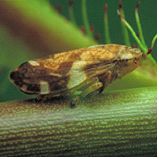
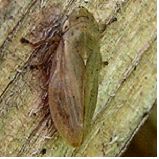
The Common Froghopper (Chaetophyes compacta) is 8mm long. Females are brownish and the males are black. It feeds solitary or conjugate in colonies. Adults can fly but will hop away immediately if disturbed.
Appearance and Distribution of the Pest
The adults and nymphs are present throughout the year in tropical to warm temperate regions and are dispersed by flying.
Life Cycle
These insects have a Hemimetabolous life cycle, ie. When the immature nymphs resemble the adults.
Females deposit eggs in tubes that are attached to the host, and several generations may appear annually on the same plant.
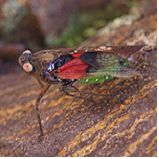
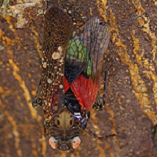 Frog Hopper with missing wing cover.
Frog Hopper with missing wing cover.
Damage Caused
Nymphs and adults are gregarious, and both stages may be found on host plants at the same time. If large numbers attack young new growth, sucking sap from leaf petioles and young stems, the host plant may become stressed. Severe infestations may weaken and eventually kill the plant.
The nymphs exude a sweet secretion, which is attractive to ants that attend and protect the colony. The honeydew also causes sooty mould to occur as a secondary problem.
Susceptible Plants
Most Eucalyptus species, Acacia species, Casuarina species and many other native or ornamental plants.
Cultural Control
Improving the culture of the host species may assist in maintaining vigorous growth, to minimise shock from infestations. It may be possible to remove them by hand from young trees, using a small butterfly net.
Biological Control
Controlled by natural predation.
Chemical Control
Under normal circumstances, it is impractical and unnecessary to treat mature trees however, Frog hoppers on young plants may be treated with a contact insecticide. Note
Always read the label for registration details and direction of use prior to application of any chemicals.
PEST
NAME
Gumtree Hopper, Jassid
Eurymela Species
ORDER
Hemiptera
FAMILY
Eurymelidae
Description of the Pest
Generally the gumtree hopper grows up to 12mm in length, resembling a small tiny cicada, and its "A"-shaped folded wings give it a characteristic triangular cross-section. The nymphs are orange, with blue markings, while the adult hopper is black or dark blue, with small white spots on its wings. Adults can fly but will hop away immediately if disturbed. Both nymphs and mature hoppers have piercing and sucking mouth parts and there are many species.
 Common Jassid
Common Jassid
Image by B. Sonsie
Common Jassid (Eurymela fenastrata) adult is black with yellow or white markings on its wings, and is a specialised hopper that only feeds on Eucalyptus species.
Appearance and Distribution of the Pest
The adults and nymphs may be present throughout the year across most of Eastern Australia, and in warm climates.


Life Cycle
These insects have a Hemimetabolous life cycle, ie. When the immature nymphs resemble the adults.
Females deposit eggs in slits they make in the bark of the host, and several generations may appear annually on the same plant.
Period of Activity
Hoppers may be active throughout the year in tropical to temperate climates.

Damage Caused
Nymphs and adults are gregarious, and both stages may be found on host plants at the same time. If large numbers attack young new growth, sucking sap from leaf petioles and young stems, the host plant may become stressed. Severe infestations may weaken and eventually kill the plant. The nymphs exude a sweet secretion, which is attractive to ants; it also causes sooty mould. Some species produce toxic saliva that kills the effected plant tissue; other species carry plant viruses.
Susceptible Plants
Most Eucalyptus species and ferny-leafed Acacia species.
Cultural Control
Improving the culture of the host species may assist in maintaining vigorous growth, to minimise shock from infestations. It may be possible to remove them by hand, from young trees, using a small butterfly net.
Biological Control
Controlled by natural predation such as small birds, spiders, assassin bugs, ladybirds and lacewings.
Chemical Control
Under normal circumstances, it is impractical and unnecessary to treat mature Eucalypts; however, hoppers on young plants may be treated with a contact insecticide.
Note
Always read the label for registration details and direction of use prior to application of any chemicals.
PEST
NAME
Cottonycushion Scale
Icerya purchasi
ORDER
Hemiptera
FAMILY
Margarodidae
Description of the Pest
This pest is also known as Ribbed Scale or Bark-louse. The small soft bodied female is oval shaped, reddish-brown, and produces an extended fluted egg sack up to 10mm long that is covered with white, waxy threads. The crawlers are red with dark legs and the adult males are winged. The nymphs infest the ribs and veins of leaves, sucking the sap. Adults and nymphs suck sap with piercing and sucking mouth-parts and ants are attracted to the honeydew produced by feeding nymphs.

 Image by B. Sonsie
Image by B. Sonsie
Appearance and Distribution of the Pest
This insect has a Hemimetabolous life cycle, ie. When the immature nymphs resemble the adults.
Adults appear during the warmer months and infest twigs branches and are found on the trunks of some trees. Ants will usually be present as feeding nymphs produce honeydew, as will the Verdalia ladybeetle, (Rodolia cardinalis), which feeds on the nymphs.
This Australian native insect has been introduced to many countries such as the USA, India, Egypt and South Africa and was only brought under control by the introduction of the Verdalia ladybeetle.
Period of Activity
There are usually two hatches each year, in early spring and late summer.
Susceptible Plants
There are many plants that are attacked by this insect including Australian native species such as Acacia, Eucalyptus, Pittosporum, Hakea and Grevilleas.
Ornamental trees and shrubs are also attacked including fruit trees and citrus, Liquidambar, Salix, Nerium, Magnolia, and Rosa species.
Palm such as Archontophoenix and Howea species are also attacked particularly when grown as an indoor or glasshouse specimen.
Damage Caused
Heavy infestations may cause die-back, particularly where natural predators are absent (eg in glass-houses). The excretion of honeydew promotes sooty mold that restricts the leaves capability to photosynthesize.
Cultural Control
Dead or damaged parts of the plant should be removed and destroyed including fallen fruit. Small infestations may be removed by hand or squashed on the stems. Healthy plants are less susceptible to attack, so maintain vigour of the plant and avoid using high-nitrogen fertiliser that produces excessive soft young growth.
When pruning susceptible plants paint the cuts with antifungal sealant paint as scale insects are attracted to the sweet smell of the sap. This will reduce the infection rate of the plant.
Biological Control
Natural predators such as parasitic wasps may reduce numbers of active nymphs; parasitic wasps are bred commercially in some areas for this purpose and the main natural predator is the Verdalia ladybeetle, (Rodolia cardinalis). It should be noted, however, that wasps would avoid dusty conditions.
Other predators that assist in control are assassin bugs, lacewings, hover flies and scale eating caterpillars. A variety of birds also attack scales.
Chemical Control
Normally not necessary.
PEST
NAME
Cup Moth
Doratifera species
ORDER
Lepidoptera
FAMILY
Limacodidae
Description of the Pest
The plump larvae are rectangular, 25mm in length, and primarily green in colour, with brightly-coloured stripes and patterns down the back. They have a pair of protuberances (turret-like) at each end of the body that contain a double row of retractable, stinging hairs, which cause a painful skin irritation if touched. The adult is a pale brown, furry moth with a 30mm wingspan.
Appearance and Distribution of the Pest
A native Australian species and is found from temperate to tropical regions. There are simular pests but different species in the USA.
Life Cycle
These insects have a Holometabolous life cycle, ie. When metamorphosis is observed during the pupal stage.
The larvae pupate in a hard, egg-shaped "cup", which is attached to the twigs of the host. The cup has a lid, which the moth removes to emerge.
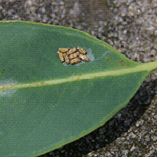 Early Larval Stage
Early Larval Stage
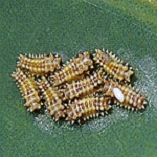
Period of Activity
Most active during Spring and Summer. Outbreaks are sporadic, with large numbers appearing in some years.
Damage Caused
Initially the gregarious young larvae skeletonise the leaves, but as they mature the caterpillars are solitary and feed on the entire leaf; heavy infestations may defoliate large trees.
Susceptible Plants
Eucalyptus, Callistemons and Melaleucas species are the main hosts of this insect. Lophostemon confertus is also commonly attacked.
Cultural Control
Remove by hand (wear hand protection).
Biological Control
Parasitic wasps make no significant difference to numbers.
Chemical Control
Spray small trees with a contact or systemic insecticides during heavy infestations.
Note
Always read the label for registration details and direction of use prior to application of any chemicals.
PEST
NAME
Tip Borer
Various Tip Borer Species
ORDER
Various
Description of the Pest
There is many species of moths which are brown, blackish or white up to 30mm long. Generally the fleshy, greenish to cream coloured larvae grow to 25mm long and are sparsely hairy. The Callistemon Tip Borer is laid by a metallic to blackish moth and the larvae are creamy grubs that have true legs. Some larvae are very active when disturbed such as the fleshy Macadamia Twig Girdler which has darker strips on its body and a dark head.
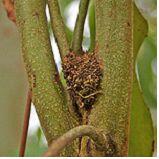 Dieback Borer Damage
Dieback Borer Damage
Dieback Borer (Platyomopsis armatula) adult is a grey-brown beetle up to 20mm long with small lumps on its wing covers and long antennae. The 15mm long cream coloured larva tunnel under the bark and feed on the sapwood causing ringbarking. The entrance to the tunnel is covered in frass and plants in the Myrtaceae family such as Eucalyptus species are susceptible.
Elm Twig Girdler (Oberea tripunctata). The adult beetle feeds on twigs causing girdling then deposits eggs during spring. The lava tunnels down the centre of the stem from the girdled point and overwinters in the tunnels. Twigs up to 14mm diameter may snap off at the damaged point and Ulmus species are normally the host.
Mahogany Shoot Borer (Hypsipyla grandella). The adult is a greyish-brown moth with a wingspan up to 45mm with the wings and veins distinctly overlayed in black. It deposits oval eggs that are tiny 0.50mm wide normally deposited in the leaf axil and change colour from white to red in the first 12 hours. In 3 to5 days the larvae emerges and can grow to 25mm long and is brownish white when young and maturing to bluish with a brown head capsule. Swietenia species are damaged as the larvae bore into the new shoots normally during spring or during the rainy season. The shoots and branches wilt then collapse. This is a major economic pest for cultivated trees.
Red Cedar Tip Moth (Hypsipyla robusta) adult is a grey moth with a wing span up to 20mm across and produces fleshy lava with true legs up to 20 mm long that tunnels into the tips of twigs. The tunnels are surrounded by webbing that is littered with pelleted droppings and is normally found on Toona species.
Staghorn Borer larvae grow to 15mm long and are greyish with true legs and the grey adult moth has a wingspan up to 20mm across. It attacks Platycerium species by eating tunnels into the sterile fronds.
Appearance and Distribution of the Pest
They are found mainly on the coast but also inland and are distributed by flying with the assistance of wind.
Life Cycle
These insects have a Holometabolous life cycle, ie. When metamorphosis is observed during the pupal stage.
Eggs are laid in bark on the growing tips. Larvae shelter in tunnels they create in the wood, up to 20mm deep.
Period of Activity
Active throughout the year in warm climates and are commonly found from tropical to sub-tropical and temperate regions.
Damage Caused
Generally the symptoms of tip borers is yellowing and curling of the leaves which wilt then die or shoots become blackened and are noticeable in the tree. Extensive feeding by a number of larvae causes dieback but normally, this is a minor pest.
The larvae emerge from their tunnels at night, to feed on the bark around the entrance holes. Entrance holes are covered by a layer of chewed wood fragments ("frass") and silk webbing. Most damage appears on twigs and new growth.
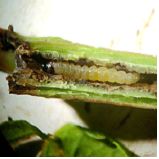 Typical larvae
Typical larvae
The Callistemon Tip Borer tunnels down the centre of the twigs causing then to die or break off and the Macadamia Twig Girdler (Neodrepta luteotactella) form tunnels in sapwood that are covered in fine webbing that is dotted in brown excreted pellets. This is the same appearance as the Banksia Web-covering Borer (Xylorycta strigata) larva makes, as it tunnels down the centre of shoots.
Susceptible Plants
Many native and ornamental plants are susceptible to tip borers such as Callistemon, Melaleuca, Banksia, Hakea, Macadamia and Stenocarpus species
Eucalyptus, Callistemon, Corymbia, Leptospermum and Melaleuca species are attacked by the Dieback Borer (Platyomopsis armatula). Twigs and small branches are attacked and the larvae causes ring bark. Affected branches break easily in high winds.
Sambucus, Yucca and Delphinium species are attacked the Common Stalk Borer (Papaipema nebris) which attacks the stems causing the plant to wilt and topple over.
Cultural Control
Larvae may be destroyed after exposure by pulling away the covering pad of frass, or by pushing a length of wire into the tunnel. Damaged branches may be removed, or tunnels plugged. Infested perennials or annuals should be removed and destroyed.
Biological Control
No effective biological control.
Chemical Control
Spray with Carbaryl (including the trunks or stems) if necessary while the insects are active.
Note
Always read the label for registration details and direction of use prior to application of any chemicals.
PEST
NAME
Emperor Gum Moth
Opodiphthera eucalypti
ORDER
Lepidoptera
FAMILY
Saturniidae
Description of the Pest
The adult moth is up to 150mm across the wingspan and is pinkish brown and has large eye-spots towards the edge of the wings.

The mature larva is up to 100mm long and is bright green with a yellow stripe on either side of its body. Each segment of the body has 6 fleshy, yellow or purple-blue and or red tubercule (protuberances) with several spiky yellowish hairs.
The larva has chewing mouth parts and the adult moth dose not feed.
The pupa is inside a fibrous spherical cocoon that is brown with a hard texture and is up to 25mm long and attached firmly to the host plant on the twigs or small branches.
This insect has a Holometabolous life cycle, ie. When metamorphosis is observed during the pupal stage.

 Large antennae
Large antennae
Appearance and Distribution of the Pest
The larvae are seen hanging in the host plant and pupate during early summer. It is distributed in sub tropical to temperate climates along the east coast of Australia from Queensland to Tasmania and can be an interesting subject in the garden.
Period of Activity
The larvae are active from late winter to early summer.
Damage Caused
The larvae chew leaves leaving large sections missing or reduce the leaf to only the mid rib. Normally not affecting the plant, and only causing problems when large numbers of larvae infest the host.
Susceptible Plants
There are a wide range of host plants which include, Eucalyptus species, Lophostemon confertus, Schinus areira, Betula pendula, Liquidambar styraciflua and Pinus radiata
Cultural Control
The larvae can be removed by hand and transferred to another host plant or squashed under foot.
Biological Control
Birds commonly eat the larvae, which reduces the numbers significantly.
Chemical Control
Chemicals may be used but normally unwarranted as the damage is not significant.
Note
Always read the label for registration details and direction of use prior to application of any chemicals.
PEST
NAME
Eucalyptus lerp
Cardiaspina species
ORDER
Hemiptera
Description of the Pest
The fleshy adult is up to 0.3mm long and covered in a patterned waxy material. The larvae have piercing and sucking mouthparts.
Period of Activity and Distribution of the Pest
Plants are attacked during the warmer months and the favourable conditions are unclear, but some years the pest is in plague proportions. It is commonly found in tropical to warm temperate climates. The fallen leaves are sticky and attaching to people and animals transferring the pest to other sites. It is found from tropical to temperate climates.
Life Cycle
These insects have a Hemimetabolous life cycle, ie. When the immature nymphs resemble the adults.

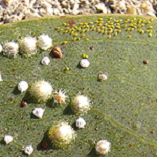
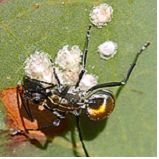
Damage Caused
The leaves are damaged on both sides develop yellow patches and fall prematurely as the nymphs and adults feed. If a tree has a heavy infestation it may completely defoliated and can lead to the death of the plant.
Susceptible Plants
All Eucalyptus species and is a major problem for many species particularly E. grandis, E. botryoides, E. robusta, E. camaldulensis and E. tereticornis.
Cultural Control
There is no effective cultural control, affected trees should be fertilised and watered to maintain vigour.
Biological Control
The syrphid fly (hover fly) is predatory and may reduce the infestation.
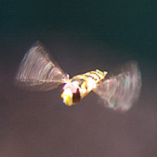
Chemical Control
It is difficult to control and contact chemicals have limited effect. Under heavy infestations tree injection may be warranted. A sleeve must be used to control the oozing latex.
Note
Always read the label for registration details and direction of use prior to application of any chemicals.
PEST
NAME
Sawfly (General)
Various Sawfly Species
ORDER
Hymenoptera
Description of the Pest
Adult sawflies are wasps that have derived the name Sawfly from the sawing action to open leaves using there ovipositor. The adults are usually colourful insects. The fleshy larvae normally are tapering caterpillars, some with pointed spine on the tale and are many different colours from black-blue to brown and orange.
These insects have a Holometabolous life cycle, ie. When metamorphosis is observed during the pupal stage.
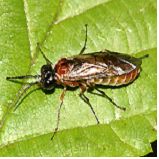
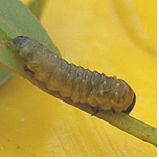
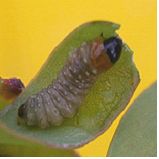
They are commonly called "spitfires" because, when disturbed, they bend back their bodies and exude a strong, eucalyptus-scented liquid from their mouths. This exudate contains concentrated eucalyptus oil, which can cause severe eye irritation. The non-feeding adults are seldom seen. Sawflies have a complete metamorphosis, pupating in cocoons in the soil for months or years.
Eucalyptus Sawfly (Perga kirbyi) lava is pale brown up to 40mm long. It is a plump grub with a black head and a yellow tipped tail and can be found in groups during the day, but spreads out at night to feed. When disturbed they react by arching there head and wiggling there tail.
European Spruce Sawfly (Diprion hercyniae) feeds on the old growth causing stunting of the host and the larvae overwinter in cocoons on the ground.
Ironbark Sawfly (Lophyrotoma interrupta) is a fleshy tapering grub up to 40mm long. It is pale brown with a black head and a yellow tip on its tail.
Long-tailed Sawfly (Pterygophorus insignis) larvae are greenish with a textured surface and a long pointed tail.
Pin Oak Sawfly (Caliroa lineata) adult is shiny-black up to 6mm long with four wings and the greenish larvae is up to 14mm long. It feeds by skeletonizing the underside of leaves turning them golden-brown as they die and an infestation in a large Quercus species is easily recognisable.
Pine Sawfly (Zenarge turneri) lays larvae that are rough and fleshy up to 10mm long with the abdomen curled.
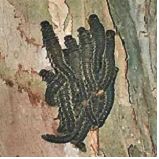 Steelblue Sawfly
Steelblue Sawfly
The adult Steelblue Sawfly (Perga dorsalis) female is steel blue in colour, with yellow antennae and legs, growing up to 20mm long, with 40mm wingspans. The insect is called a "sawfly" because of the sawing action of the ovipositor. The yellowish-brown larvae have chewing mouth parts.
Appearance of the Pest
During the day, sawflies congregate in clusters, separating at night to travel and feed on the foliage of the host plant.
Period of Activity
Caterpillars appear in spring through summer and are found from tropical to sub-tropical and temperate regions.
Susceptible Plants
There are many ornamental and Australian native plants that are attacked including Eucalyptus camaldulensis, E. blakelyi, E. melliodora, and E. pauciflora and Callistemon, Leptospermum species.
Eucalyptus species are attacked by the Eucalyptus Sawfly (Perga kirbyi) which can defoliate a tree.
Larix species are attacked by the Larch Sawfly (Pristiphora erichsonii). The adult wasp-like fly deposits eggs in an incision on the twigs during late spring and the 25mm long olive green spiny larvae chew the needles. The larvae overwinter on the ground in brown cocoons.
Melaleucas are also attracts the Paperback Sawfly.
Pinus and Callitris species are attacked by up to four species including the Pine Sawfly (Diprion simile).
Sorbus aucuparia is attacked by the Mountain Ash Sawfly (Pristiphora jeniculeta). The larvae feed on the leaves, leaving only the mid rib and main veins. Heavy infestations causes serious defoliating of the tree.
Viola species are attacked by the Sawfly (Ametastegia pallipes) which eats the leaves skeletonising them.
Damage Caused
Generally the larva eat the surface of leaves, skeletonising them when young, but as they develop they eat large pieces leaving only the mid rib. They tend to feed on the terminal shoots, and heavy infestations can defoliating young trees.
Cultural Control
Clustering larvae may be hosed or knocked from branches, falling to the ground where they can be squashed under foot or attacked by other predators. At night when the larvae congregate they can be collected and disposed off. In small infestations they can be picked by hand and destroyed.
Biological Control
The exudate causes most birds to avoid the larva, although cockatoos remove the head and oil gland prior to consumption. They are also eaten by lizards and frogs or attacked by parasitic wasps.
Chemical Control
Affected plants can be sprayed using Maldison or Carbaryl, this is only possible for small trees.
Note
Always read the label for registration details and direction of use prior to application of any chemicals.
PEST
NAME
Leafblister Sawflies
Phylacteophaga species.
ORDER
Hymenoptera
FAMILY
Pergidae
Description of the Pest
There two commonly seen Leafblister Sawflies are (Phylacteophaga eucalypti) and (Phylacteophagafroggatti) which have simular feeding habits and life cycle.
Generally the larvae of the leaf blister sawflies are segmented and up to 6mm long; feeding on the inside of the leaf where they are only visible if the blistered leaf cuticle is removed. Adults are sawflies, 5mm long that live for about one week.
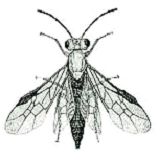
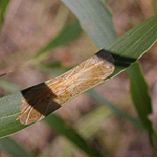 Blister on Acacia longifolia
Blister on Acacia longifolia
Appearance and Distribution of the Pest
Appears both coastally and inland, in temperate areas of Eastern Australia.
Life Cycle
The complete lifecycle takes 6 weeks in the warmer months; longer during winter. The sawfly has a complete metamorphosis, with 4-8 generations each year. Females lay eggs in slits that they have made in the leaf veins. The leaf swells around the eggs, forming galls. Larvae feed between the leaf surfaces, causing blistering. The larvae pupate within the blister.
These insects have a Holometabolous life cycle, ie. When metamorphosis is observed during the pupal stage.
Period of Activity
Damage occurs during the warmer months. Young plantations, or trees stressed by drought, are particularly susceptible during these times.
Damage Caused
Mining between the upper and lower leaf surfaces causes blisters, giving a brownish burnt appearance. Heavy infestations may defoliate the plant and repetitive attacks can lead to dieback. The sawfly does not lay eggs above heights of 4m, thus mature trees are unlikely to be seriously damaged. The appearance of the host plant becomes unsightly after an infestation with disfigured leaves.
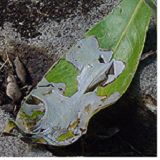
Susceptible Plants
There are many species that are attacked including Acacia and Eucalyptus species, juvenile foliage is commonly attacked particularly (E. grandis, E. Saligna, E. botryoides & E. robusta, Eucalyptus tereticornis).
Callistemon species, Lophostemon confertus and Buckinghamia celsissima are also susceptible to attack.
Cultural Control
Remove and destroy infested leaves or seriously damaged plants. Mature plants are unlikely to suffer serious damage, unless under stress.
Biological Control
No effective biological controls are known, although natural predators such as parasitic wasps and small birds eat many larvae.
Chemical Control
Systemic pesticides may be sprayed if the blisters are small and the larvae are active - otherwise, chemicals have a limited role.
Note
Always read the label for registration details and direction of use prior to application of any chemicals.
PEST
NAME
Bugs (General)
Various Bug Species
ORDER
Hemiptera
Description of the Pest
Generally bugs are sap sucking insects with a strong proboscis and are commonly shield shape. They may be dull grey-brown or brightly coloured with long anatine and legs. They feed in colonies or solitary and cause excessive damage due to the toxic saliva they inject into the plant. They also are capable of emitting a nauseous smell or squirting a caustic fluid when disturbed or they fly away. Both adults and nymphs have piecing and sucking mouthparts and adults commonly shelter under plant litter or under bark during winter.

 Cotton Harlequin Bug (Male)
Cotton Harlequin Bug (Male)
Cotton Harlequin Bug (Tectocoris diophthalmus) adult female is up to 20mm long and is orange-yellow with black patches on its wing covers. The smaller male is reddish with bright metallic blue or green markings. Eggs are laid in a spiral arrangement around twigs and both eggs and nymphs are guarded by the adult female.
Adults and nymphs have piercing and sucking mouthparts and cause little damage to the host plant, though may be found in large numbers. They appear during late winter and are more prevalent along coastal regions on plants from the Malvaceae family such as Lagunaria patersonii. Control is not normally warranted.
Crusader Bug (Mictis profana) is a light brown elongated bug to 20mm. It has distinctive pale yellow cross mark, depressed on its back and large rear legs. It has long antennae that are tipped in yellow and when disturbed can secrete a foul smelling caustic fluid. The immature stages (nymphs) are brownish with no cross and marked with two small orange spots on the abdomen.
Both adult and nymph have piecing and sucking mouth parts and are solitary feeders on tender new shoots causing wilting and dieback. They are found on a wide range of plants including Hibiscus and Acacia species and normally do not require control.
Eucalyptus Tip Bug (Amorbus alternatus) adult is a blackish shield-shaped insect up to 20mm long with a spine on each shoulder. The wing covers are marked with a yellowish 'V' pattern and the lava are brightly coloured in shades of blue and orange with its body tapering towards the head.
 Harlequin Bug
Harlequin Bug
Harlequin Bug (Dindymus versicolor) is very colourful with red or black upper parts and a green to yellowish abdomen and is up to 12mm long. The wingless nymphs are also brightly coloured and are commonly found in temperate climates on plants and structures such as fences. .
There is also another Harlequin Bug (Murgantia bistrionica) that is found in North America and has simular colourings, habits and grows to 10mm long. The adult lays eggs in double rows on the underside of leaves.
Metallic Shield Bug (Scutiphora rubromaculata) is up to 10mm long. The adult is brightly coloured in metallic blue with two obvious red blotches on its thorax. It is found in tropical to sub tropical regions.
Plant Bug (Hallicotoma valida) is small and blue-black, which slightly engraves the epidermal layer of the leaf turning it yellow and is found on Yucca species.
Rutherglen Bug (Nysius vinitor) is dull grey with silvery wings that up to 5mm long and the winged nymphs are also grey.
 Bronze Orange Bug
Bronze Orange Bug
 Bronze Orange Bug Nymph
Bronze Orange Bug Nymph
Appearance and Distribution of the Pest
Generally nymphs appear in winter after hatching from eggs that were laid in late summer under the leaves, generally unnoticed apart from a strong smell.
They are found throughout the world in tropical, sub tropical to temperate regions. They appear from late winter to late autumn and can be seen on the new growth and fruit.
Rutherglen Bug can form large colonies causing the new growth to wilt or stem tissue forms a dry area. It can become a serious pest requiring control.
Life Cycle
These insects have a Hemimetabolous life cycle, ie. When the immature nymphs resemble the adults.
There are five nymphal stages with the eggs laid during late winter and up to 4 generations each season. Certain species of adults tend the eggs until they hatch. The insect over winters as an adult.

 Harlequin Bug
Harlequin Bug
Period of Activity
This pest is active throughout spring and summer, with large numbers occurring in autumn.
Damage Caused
Generally the nymphs and adults feed on new shoots, the underside of leaves, flowers and stems of plants and mature bugs feed on fruit or seeds. This causes bean pods to become shrivelled and distorted, or tomatoes form mottled areas and peaches exude clear gum. Leaves and flowers wilt or shrivel and die. The North American Harlequin Bug forms white or yellow blotches on the leaf surface causing plants to wilt and die.

Susceptible Plants
There is a wide range of plants that are attacked by various bugs including legumes such as beans or lucerne or pumpkin, spinach, passionfruit and many ornamental and native trees and shrubs. Fruit trees and weeds are also attacked.
Abutilon, Alyogyne, Hibiscus species, Vitis vinifera (grape) and Lycopersicon esculentum (tomato) are susceptible to attack by Harlequin Bug (Dindymus versicolor) causing damage to new growth and blemishing fruit with there excrement. Many vegetables and fruit trees are also susceptible to attack.
Abutilon, Alyogyne, Hibiscus species are also attacked by the Cotton Harlequin Bug (Tectocoris diophthalmus).
Eucalyptus species are attacked by the Eucalyptus Tip Bug (Amorbus alternatus). The slow moving adults suck sap from the host solitary or in groups causing wilting and sometimes dieback of the branches. It is not regarded as a major pest and control is not normally required.
Ficus and Melaleuca species are attacked by the Metallic Shield Bug (Scutiphora rubromaculata).
Acacia, Cassia, Citrus, Hibiscus, Senna species and Vitis vinifera are susceptible to attack by the Crusader Bug (Mictis profana) damaging new shoots.
Leucanthemum species are attacked by the Four-lined Leaf Bug (Poecilocapsus lineatus). The adult is yellow with four black stripes on its wings and attacks the leaves causing spotting that turns them brown, eventually dieing.
Pennisetum clandestinum (Kikuyu) is attacked by the Billbug (Spenophorus brunnipennis). This weevil produces larva that can be seen at the soil level and are legless up to 10mm long with a brown head and a cream coloured curved body. During early summer affected leaves turn yellow and a second generation may occur in late summer.
Bluegrass Billbug (Sphenophorus parvulus) attacks Poa pratensis (Kentucky Bluegrass).
Cultural Control
Small infestations may be carefully removed by hand or hosed off then collected. Heavily infested plants or plant parts may be removed and destroyed. Weed control around the plants may increase possible infestation as the bugs migrate to a new host. A barrier of annuals may be planted around susceptible plants as to attract the bugs once the annual weeds die off.
Remove all rubbish such as woodpiles or garden wast or rubbish from the garden as bugs tend to shelter in these areas. Susceptible plants may be sprayed up to three times during the cooler months with a soapy or glue spray on both sides of the leaves in order to kill the nymphs.
Hosing may also dislodge adult bugs and once on the ground they can be squashed. Another novel method for removal is to use an electric or portable vacuum cleaner to suck the bugs from the host plant. This method is excellent on several species including stink bugs and Christmas beetles.
Biological Control
Bugs are attacked by many predators including; birds, spiders, assassin bugs, parasitic wasp and parasitic fungi. These predators combined still have little control over infestation of susceptible plants.
 Assassin Bug Nymph
Assassin Bug Nymph
Chemical Control
Spraying with insecticides is effective, such as Fenthion, Maldison or Dimethoate. Always read the label for registration details and direction of use.
Note
Always read the label for registration details and direction of use prior to application of any chemicals.
PEST
NAME
Gall Flies (General)
Various Gall Flie Species
ORDER
Diptera
FAMILY
Cecidomyiidae
Description of the Pest
There is about 100 species of flies that are known as gall gnats or gall midges. They infect particularly the leaves usually forming pimple like galls. The buds and stems are also attacked and the galls can be large.
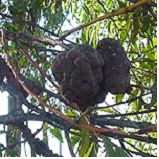 Blossom Gall Fly on Acacia species
Blossom Gall Fly on Acacia species
Blossom Gall Fly (Cecidomyia acaciaelongifoliae) attacks spent flowers heads forming large twisted galls that are made up of tubes containing maggots that feed on the flower heads and causing the seed to become malformed, into galls. Not normally requiring control, but plants appear ugly.
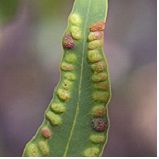
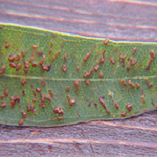
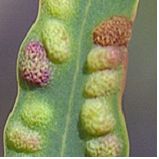 Pimple Gall on Eucalyptus species.
Pimple Gall on Eucalyptus species.
Pimple Gall (Harmomyia omalathi) forms small reddish pimple-like galls that may appear along the mid rib.
Callitris Gall (Diplosis frenalae) is a large gall that that splits in to six sections and looks very simular to a Callitris cone.
Cone Gall (Rhabdophaga strobiliodes) is produced by a small fly that deposits eggs in opening buds. Lave overwinter in the cone shaped galls that inhibit the development of the bud. It is found on Salix species.
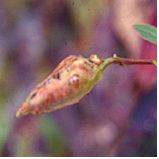 Fergusonina Galls
Fergusonina Galls
Image by B. Sonsie
Fergusonina Galls (Fergusonina species) are the result of a symbiotic relationship between leaf nematodes and gall flies such as (Fergusonina nicholsoni). In all cases the nematodes are deposited along with the fly's lava and together they feed on the leaves forming galls, which can become large sometimes cover the entire leaf. The nematodes increase in numbers and when the fly emerges it is infested with them, which are then deposited in the new nest completing the cycle.
Appearance and Distribution of the Pest
The adult infect plants from spring to autumn and are distributed by flying with the assistance of wind. The larvae may also be distributed in infected cuttings or leaves that are transported to another site.
Life Cycle
These insects have a Holometabolous life cycle, ie. When metamorphosis is observed during the pupal stage.
The larvae of these insects are known as maggots. They have chewing mouthparts and the adults have piercing and or sucking mouthparts and one pair of wings.
Period of Activity
Generally the flies are more active during the warmer months of the year and are found in sub tropical to temperate regions particularly on the coast.
Damage Caused
When flowers are attacked the maggot interferes with seed formation and stimulates the growth of galls. Many species of Gall Fly feed off the plant from within the gall and certain species such as Fergusonina Galls (Fergusonina species) forms a symbiotic relationship with nematodes and both feed from within the gall. The leaves are the normal area attacked, but stems are also infected such as the new stems in Callitris species.
Susceptible Plants
There are many species attacked including Acacia, Eucalyptus, Callitris, and Pittosporum species.
Catalpa species are attacked by the Midge (Cecidomyia catalpae) which lays eggs in the leaves and the emerging lava eat circular sections of the leaf surface causing distortion.
Eucalyptus species are attacked by various Fergusonina Galls which may alter the flowering or seed production of the host.
Viola species are attacked by the Gall Fly (Phytophaga violicola) which attacks the leaves forming galls and distorting its shape. After time the leaves form wet-rot and the plants development is dwarfed.
Cultural Control
Pick off the damaged leaves where possible prior to the emerging adult and destroy. This will reduce build up of the population, but if there is evidence of emergent holes in the gall it is too late. Plants that are repetitively attacked should be removed and the area re-planted with a less susceptible species. Infected trees respond to fertilising and watering to improve vigour against the attack.
Biological Control
Parasitic wasps lay there eggs in the galls and some species of nematode eats the larvae prior to emergence.
Chemical Control
Chemicals may be injected or sprayed but normally has limited effect as the insect is inclosed within the gall and is difficult to monitor.
Note
Always read the label for registration details and direction of use prior to application of any chemicals.
PEST
NAME
Fruit Tree Borer
Maroga melanostigma
ORDER
Lepidoptera
FAMILY
Oecophoridae
Description of the Pest
Adults are white, satiny moths with 40-60mm wingspans; their black abdomens are fringed with orange-brown hair and tufted at the tip. Larvae are reddish brown with a few hairs, up to 50mm in length.
Appearance and Distribution of the Pest
An Australian native pest that is found on the coast or inland from temperate to subtropical regions.
Life Cycle
This insect has a Holometabolous life cycle, ie. When metamorphosis is observed during the pupal stage.
Eggs are laid singly, in bark normally in the branch junctions. After the eggs hatch the larvae shelter in the shallow tunnels they create in the wood, up to 60mm deep. The tunnel entrance is closed with webbing and the lava pupates, emerging the following summer.
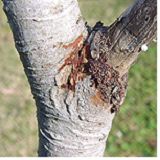
Period of Activity
The pest is active throughout the warmer months and the lava overwinters in its sealed tunnel.
Damage Caused
Larvae emerge from their tunnels at night, to feed on the callus tissue around the entrance holes. Entrance holes are covered by a layer of chewed wood fragments ("frass") and silk webbing. Most damage appears on the branches, especially at junctions. Extensive feeding may girdle the branch cause ring-barking.
On inspection, the wound is covered in webbing material and on removal the true extent of the damage is revealed, bear wood. These areas may be infected by wood rot fungi.

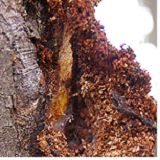
Susceptible Plants
There are many plants that are attacked by the Fruit Tree Borer including; Acacia, Banksia, Callicoma, Lagerstroemia, Eucalyptus and Jacaranda species, and flowering stonefruit.
Factors that contribute to attack are infertile poorly drained soils or damage to the bark, mechanically or from sunscald.
Cultural Control
Larvae may be destroyed after exposure by pulling away the covering pad of frass, or by pushing a length of wire into the tunnel. Damaged branches may be removed. Use correct tree surgery techniques to seal the wound.
Improve the vigour of the tree by lightly cultivating the surrounding soil then fertilise and water. It may also be lightly pruned to encourage new growth.
Biological Control
No effective biological control, but several parasites and predators keep the numbers down.
Chemical Control
Spray with Contact insecticides (including the trunks).
Note
Always read the label for registration details and direction of use prior to application of any chemicals.
PEST
NAME
Cicadas
Various Cicada Species
ORDER
Hemiptera
FAMILY
Cicadidae
Description of the Pest
Cicadas are sap-sucking insects, up to 60mm in length. They penetrate soft shoots with their long proboscis. The nymph is subterranean and also has piercing and sucking mouthparts; it feeds on the roots of the plant. The nymph emerges to shed its skin and become a winged adult; the discarded nymph shell (exoskeleton) is often seen on tree trunks and wooden fences during summer. Adults are best known for their constant high-pitched chirping as the temperatures increase during summer months.
 Adult Black prince
Adult Black prince
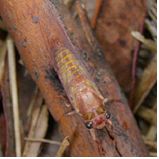 Adult Cicada
Adult Cicada
Adults of different species may be black, green, brown, orange or yellow.
Common species include the green grocer (Cyclochila australasiae); black prince (Pasltoda argentata); double drummer (Thopha saccata); and floury baker (Abricta curvicosta).
Life Cycle
This insect has a Hemimetabolous life cycle, i.e. nymphs and adults.
The nymphs remain underground for several years; they emerge and become adults during late spring to early summer. Eggs are deposited into slits made by the female in the bark of host plants - this process may cause die-back.
Distribution of the Pest
World wide including Australia
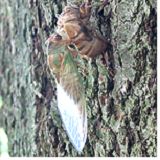 Adult emerges from the exoskeleton of the nymph
Adult emerges from the exoskeleton of the nymph
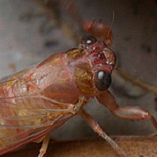 Adult Cicada
Adult Cicada
Period of Activity
Adults remain active throughout the warmer months of the year.
The larvae are feeding in the soil for many years all year round.
Damage Caused
This is a large, noisy insect whose presence seldom causes serious damage to plants.
Soft shoots on which the adults feed may wilt. Adults produce an exudate similar to honeydew. Loud noise is due to the males only (up to 120 decibels) can also be a problem.
Dieback to stem can result due to the activities of the females laying their eggs in the young stems
Susceptible Plants
Cicadas feed on a wide range of native plants - including Eucalypts and exotics.
Control
Natural predators including birds, possums and spiders may reduce numbers.
Cicadas are a minor pest and control measures are not usually necessary. They are an important component of the Australian ecosystem.
Note
It is your responsibility by law to read & follow the directions on the label of any pesticide
Amendments by B. Sonsie Dip Hort Sc Burnley
PEST
NAME
Eucalyptus Leaf Beetles
Various Leaf Beetle Species
ORDER
Coleoptera
FAMILY
Chrysomelidae
Description of the Pest
There are many beetles that attack the foliage of plants with one group specialising in Eucalyptus species. These adult beetles have a rounded spherical shape up to 15mm long with small antennae and large feet. The colour varies from yellow-brown, grey, black or green.
The larvae are pale cream-yellow and normally with black areas on the body. Both larva and adult have chewing mouthparts.

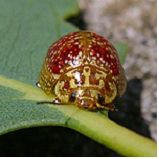
Life Cycle
This insect has a Holometabolous life cycle, ie. When metamorphosis is observed during the pupal stage.
The eggs are laid on stems or on the petiole of leaves. They are arranged in a circular pattern in compact rosettes and are a creamy white colour. The larvae pupate in the soil.
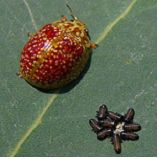
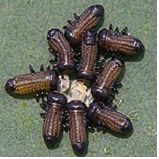
Period of Activity and Distribution of the Pest
This pest normally occurs during the warmer months and is found throughout Australia. It is not known what climatic conditions are favourable.
Damage Caused
The adults and larvae eat the leaves. The adults eat mature and new leaves along the margins leaving them scalloped. The larvae tend to attack the juvenal leaves at the top and outer parts of the tree eating them in an irregular manner, often leaving only the midrib. They normally appear in groups.
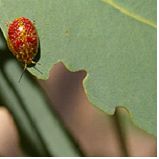
Susceptible Plants
These beetles attack many species of Eucalyptus and some species of Acacia.
Cultural Control
The pest may be removed by hand if the infestation is small and plants that are under attack may be helped with improved culture, ie Fertilising, watering and mulching.
Biological Control
The larvae are attacked by birds and large ants, which diminish the numbers significantly.
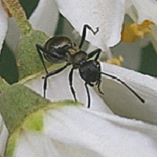 Large Ant
Large Ant
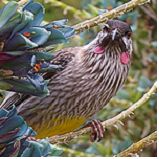 Birds
Birds
Chemical Control
If the infestation is severe a contact pesticide may be used but normally it is unwarranted.
Note
Always read the label for registration details and direction of use prior to application of any chemicals.
PEST
NAME
Gumleaf Skeletoniser
Uraba lugens
ORDER
Lepidoptera
FAMILY
Noctuidae
Description of the Pest
The adult moth can have a wingspan of up to 250mm and are silvery grey with darking makings on the forewing tips. It can lay its eggs in groups, of up to 200. The larva is yellowish brown and can grow up to 25mm when fully fed. It has a prominent horn like projection on its head, which is actually a stack of outgrown, cast off head capsules. The larva is covered in white hairs that can cause localised skin irritations.
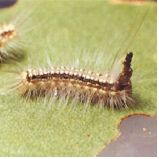
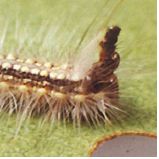
Appearance and Distribution of the Pest
The adult lays its eggs during Spring and the larvae are active throughout the warmer months. This pest is widely distributed throughout the temperate and subtropical regions and its favoured conditioned have not yet been documented.
Life Cycle
This insect has a Holometabolous life cycle, ie. When metamorphosis is observed during the pupal stage.
The adult lays eggs of the surface of the leaves where the larvae feed. After which it may, drop to the ground on silken threads, or remain on the bark of the host tree to pupate.
Period of Activity
The feeding larvae are active during the warmer months of the year.
Damage Caused
The gregarious larvae skeletonise the leaf by eating the leaf blade, leaving the veins; mature larvae can chew large sections of the leaf away. The skeletonised leaves turn brown and give the host plant a burnt appearance during heavy infestations of the pest.
Susceptible Plants
Many species of Eucalypts are attacked, particularly Snow Gum (E. paucifolia), Red River Gum (E. camaldulensis), Blackbutt (E. pilularis) and Sydney Blue Gum (E. saligna).
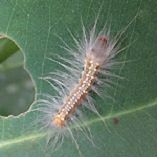
Cultural Control
Physical removal of foliage on young plants. where the eggs are clearly visible.
Biological Control
There is no effective biological method of controlling this pest.
Chemical Control
Tree may be sprayed with a contact pesticides in conjunction with a wetting agent (to penetrate the hairs on the caterpillar's body) are often successful.
Note
Always read the label for registration details and direction of use prior to application of any chemicals.
PEST
NAME
Jewel Beetles
Various Jewel Beetle Species
ORDER
Coleoptera
FAMILY
Buprestidae
Description of the Pest
There are many species of Jewel beetles and generally have flat and elongated bodies with metallic, iridescent-patterned shells in orange red or yellow. The plump larvae are cream-coloured legless grubs, shaped like a cobra head with a large body segment behind the head.
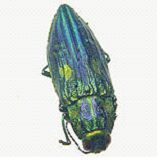
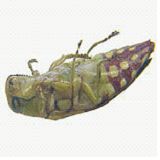
Appearance and Distribution of the Pest
They are common throughout Australia particularly in the drier regions.
Life Cycle
This insect has a Holometabolous life cycle, ie. When metamorphosis is observed during the pupal stage.
Eggs are laid in cracks in the bark of the host, upon which the mature larvae pupates.
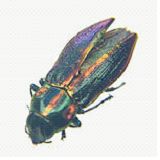
Period of Activity
Most active from spring through summer.
Damage Caused
The larvae feed beneath the bark, producing oval (in cross-sectioned) tunnels with much sawdust ("frass") around the entrance. The larvae burrow into the cambium layer. Stressed or damaged plants are more susceptible to infestation and may display branch die-back; occasionally the larvae may ring-bark the trunk.
Susceptible Plants
Many plants are attacked especially in the Myrtaceae family such as the Eucalyptus, Leptospermum and Melaleuca species. Allocasuarina are also attacked.
Banksia species may be attacked by the Banksia Borer (Cyria imperialis).
Cupressus species are attacked by the Cypress Jewel Beetle (Diadoxus erythrurus).
Cultural Control
Remove damaged branches or repair using arboriculture techniques. Improve the culture of the plant.
Biological Control
No effective biological controls.
Chemical Control
No practical chemical control of the larvae is available. Tree injection is unsuccessful because the larvae tunnel into the woody part of the plant.
Note
Always read the label for registration details and direction of use prior to application of any chemicals.
PEST
NAME
Nectar Scarabs
Phyllotocus species
ORDER
Coleoptera
FAMILY
Scarabaeidae
Description of the Pest
Adult beetles have a characteristic scarab shape, up to 6mm in length, with exaggerated hind legs. The head and thorax is dark brown; the wings have orange-brown longitudinal striations. Larvae appear as small white curl grubs. Both larvae and adults have chewing mouth parts.
Flower Scarab Beetles (Protaetia apecies). Thiese active beetles are stout and broad up to 20mm long. The colouring is normally brown with some having small pale markings on the wing covers. It is commonly found feeding on Myrtaceae or Proteaceae flowers (pollen) or shoots of Acacia species. It is a solitary feeder and may cause dieback of the host.

Appearance and Distribution of the Pest
Nectar scarabs are Australian natives but are rarely found in the Northern Territory. They are distributed by flying to a new host plant.
Life Cycle
These insects have a Holometabolous life cycle, ie. When metamorphosis is observed during the pupal stage.
It has a complete metamorphosis producing one generation every one to three years, depending on the species. The eggs are laid during spring normally near the surface of the soil and the lava burrow into the soil. The lava overwinters deep in the soil and pupates during spring.
Period of Activity
Most active during the warmer months, when plants are flowering.
Damage Caused
Larvae feed on decaying vegetable matter and cause little damage. Adults swarm on host plants in large numbers, feeding on pollen and nectar; when swarming they may also feed on the flower parts.
Susceptible Plants
Many plants are attacked by this insect including Acacia, Eucalyptus, Melaleuca and Callistemon species. Ornamentals such as Rosa and Dahlias species are also attacked.
Cultural Control
Small infestations may be removed by hand but certain species such as the Flower Scarab Beetle drop to the ground and pretend to be dead. This is an opportunity to collect them on a piece of plastic if it is spread around the plant.
Biological Control
No known controls.
Chemical Control
Contact insecticides such as Carbaryl are effective, but not normally necessary.
Note
Always read the label for registration details and direction of use prior to application of any chemicals.
PEST
NAME
Soldier Beetles
Chauliognathus lugubris
ORDER
Coleoptera
FAMILY
Cantharidae
Description of the Pest
Adults are narrow, with dull green wing covers, black heads with a yellowish orange band at the base of the thorax; the tip of the abdomen is also yellowish orange. Adults and larvae have chewing mouth parts.
Appearance and Distribution of the Pest
Occurs throughout Australia and are found on many flowering plants awaiting the arrival of other insects or lava to feed off.

Life Cycle
This insect has a Holometabolous life cycle, ie. When metamorphosis is observed during the pupal stage.
Period of Activity
During flowering in warmer months.
Damage Caused
Larvae and adults feed on caterpillars and scale. Adults also feed on nectar and, in large numbers may cause physical damage to host flowers and disturb fruit setting.
Susceptible Plants
This insect may be found on all flowering plants but is rarely a pest. Eucalyptus species is commonly a host.
Cultural Control
Remove by hand (not normally required).
Biological Control
None known.
Chemical Control
Not normally required but if spraying is required it should be carried out in the late afternoon and predominantly directed on the swarm. Spraying may also kill beneficial insects such as bees.
Note
Always read the label for registration details and direction of use prior to application of any chemicals.
PEST
NAME
Steelblue Sawfly
Perga species
ORDER
Hymenoptera
FAMILY
Pergidae
Description of the Pest
Adult females are steel blue in colour, with yellow antennae and legs, growing up to 20mm long, with 40mm wingspans. The insect is called a "sawfly" because of the sawing action of the ovipositor. The yellowish-brown larvae have chewing mouth parts.
The larvae are called "spitfires" because, when disturbed, they bend back their bodies and exude a strong, eucalyptus-scented liquid from their mouths. This exudate contains concentrated eucalyptus oil, which can cause severe eye irritation. The non-feeding adults are seldom seen. Sawflies have a complete metamorphosis, pupating in cocoons in the soil for months or years.
These insects have a Holometabolous life cycle, ie. When metamorphosis is observed during the pupal stage.
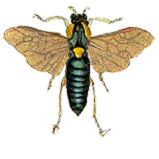
Appearance of the Pest
During the day, sawflies larva congregate in clusters, separating at night to travel and feed on the foliage of the host plant.
Period of Activity
Caterpillars appear in spring through summer.
Susceptible Plants
Eucalypts, especially E. camaldulensis, E. blakelyi, E. melliodora, and E. pauciflora and others.
Damage Caused
Generally the larva eats the surface of leaves when young, but as they develop they eat large pieces leaving only the mid rib. They tend to feed on the terminal shoots, and heavy infestations can defoliating young trees.
Cultural Control
Clustering larvae may be hosed or knocked from branches, falling to the ground where they can be squashed under foot or attacked by other predators. During the day when the larvae congregate they can be collected and disposed off. In small infestations they can be picked by hand and destroyed.
Biological Control
The exudate causes most birds to avoid the larva, although cockatoos remove the head and oil gland prior to consumption. They are also eaten by lizards and frogs or attacked by parasitic wasps.
Chemical Control
Affected plants can be sprayed using Maldison or Carbaryl, this is only possible for small trees.
Note
Always read the label for registration details and direction of use prior to application of any chemicals.
PEST
NAME
Gumtree Scale
Eriococcus coriaceus
ORDER
Hemiptera
Description of the Pest
The tiny female is pale brown soft scale; it only becomes plainly visible when its egg-sack develops, growing up to 3mm long and becoming darker. Males are a small, flat, white scale and apparent in large clusters. Scales have sucking and mouth parts.
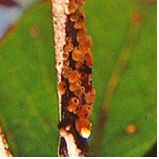
Appearance and Distribution of the Pest
An Australian native pest that occurs during the warmer months of the year. Similar to the Abo.
Life Cycle
This scale is hemimetabolous. Females lay eggs in egg-sacks, from which nymphs emerge.
Period of Activity
The pest is most active from spring through summer.
Damage Caused
Nymphs and adults cause damage by sucking the sap. Stressed and immature plants are particularly susceptible to damage: dieback of affected branch may occur during heavy infestations, and infestations on the main stem may kill young plants. Scales produce honeydew, which causes sooty mould.
Susceptible Plants
Many Eucalyptus species; some species are more susceptible than others.
Cultural Control
Remove and destroy the branches. Small infestations may be rubbed off by hand (wear gloves).
Biological Control
Ladybirds are natural predators, but have limited influence on control of numbers.
Chemical Control
Spray the infested branches with white oil; emergent nymphs may be sprayed with contact insecticide.
PEST
NAME
White Stemmed Gum Moth
Chelepteryx collesi
ORDER
Lepidoptera
Description of the Pest
Adults are dull brown moths with obvious zig zag pattens on the wings. Larvae are plump and fleshy caterpillars up to 100mm long, dull red with yellow bands and have tufts hairs on each segment. Pupating larvae form a silken bag that tapers at each end and are armed with protruding irritating hairs.
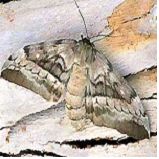

Appearance and Distribution of the Pest
Common throughout eastern Australia from tropical to temperate regions and predominantly on the coast. They are solitary feeders.
Life Cycle
This insect has a Holometabolous life cycle, ie. When metamorphosis is observed during the pupal stage.
The caterpillars pupate in silken cocoons that may be found some distance from the feeding area, such as under the eves of buildings.
Period of Activity
They are most active during the night; during the day they move to the lower parts of the tree and hide in bark crevices. They are most active during Spring and Autumn.
Damage Caused
Large pieces of leaves are eaten or the leaf is stripped back to the midrib. The caterpillars can defoliate a small tree; they migrate en masse to the next host tree.
Susceptible Plants
Angophora and Eucalyptus species
Cultural Control
The caterpillars may be removed by hand, but take care and wear gloves as it has irritating hairs.
Biological Control
Parasites and predators contribute to the control of numbers.
Chemical Control
Spraying has little effect as this is a nomadic caterpillar.
Note
Always read the label for registration details and direction of use prior to application of any chemicals.
PEST
NAME
Mistletoe
Various Mistletoe Species
Description of the Pest
This is not an insect pest but a group of parasitic plants, some specific to the host and others that attack a wide range of hosts. The mistletoe is seen as a pendant cluster of bright green leaves on the branches of the host plant. It has bright flowers that produce nectar, attracting birds which spread the seeds.
 Cluster of bright green leaves
Cluster of bright green leaves
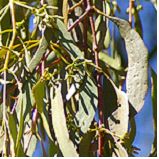
Appearance and Distribution of the Pest
It can appear throughout the year in warmer climates, otherwise seeds germinate from spring to summer. The seeds are distributed by birds that land on the host plant and deposit seeds.
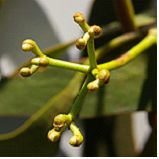 Flower Head
Flower Head
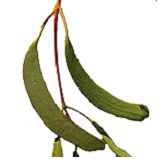 Leaves
Leaves
Period of Activity
Infestation occurs primarily during summer but growths may be seen throughout the year.
Damage Caused
Seeds germinate on the host and form a connection, not killing the cells but working with them in order to feed on the sap with ever enlarging roots. Small infestations do little harm to the host but vigorous species may infest trees eventually killing them. This is a serious problem in cleared land where small stands of trees have been left and generally have no follow up saplings.
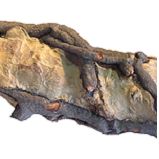 Enlarging Roots
Enlarging Roots
Susceptible Plants
Normally attacks trees that are in an open sunny exposed position such as a roadside setting or an isolated specimen. Stressed trees are particularly venerable and are easily killed.
Calocedrus decurrens is attacked by the leafy mistletoe (Phoradendron juniperinum).
Cultural Control
Cut off and destroy clumps and feed the plant to improve vigour. Removal of the plant is an important maintenance procedure in small groups of trees to reduce losses.
Biological Control
There is no current biological control.
Chemical Control
The tree may be injected with a systemic poison, but great care should be taken as the correct chemical and dosage rate is critical. Contact the local Dept. of Agriculture for advice.
Note
Always read the label for registration details and direction of use prior to application of any chemicals.
PEST
NAME
Grasshoppers and Locusts
Various Grasshopper Species
ORDER
Orthoptera
Description of the Pest
Grasshoppers and locusts are simular but varying in colour. Grasshoppers are a solitary insect while Locusts tend to feed in swarms that vary in size from season to season, depending on climatic conditions. Generally there are two types of insect, one with antennae that are longer than its body (long-horned grasshopper) and are regarded as a solitary feeder. The other insects have short antenna and are known as (short-horned grasshopper) and include species that swarm, examples are below.
The adults may be winged, short-winged with the forewing thicker forming a cover when at rest, or wingless. Some male species can produce sound from special forewings, abdomen and hind legs. They all have enlarged hind legs designed for jumping and are usually well camouflaged.
Nymphs are simular to the adults but smaller and wingless, both have chewing mouthparts.


Australian Plague Locust (Chortoicetes terminifera) is a brown adult short-horned grasshopper with females up to 40mm long and has black markings on the transparent hindwings. The smaller male is simular and both are heavy feeders eating large pieces out of leaves. They are found from tropical to temperate zones forming plagues that migrate and consume all that is in its path.
Giant Locust (Valanga irregularis) is a large brownish short-horned grasshopper up to 80mm long with transparent hind wings and the bright green nymphs do not resemble the adults. Both adults and nymphs feed on leaves, eating large pieces and attacking Palms or Hibiscus species. Common in tropical and sub tropical regions.
Green Gum Tree Hopper (Torbia perfecta) adult is a long-horned grasshopper up to 50mm long with antennae that grow to 60mm in length and has folded flat wings that resemble a leaf. It is a solitary feeder that is found from sub tropical to temperate regions attacking primarily Eucalyptus species.
Katydid (Caedicia olivacea) adult is dark green long-horned grasshopper up to 50mm long and grows antennae to 60mm long. Its wings fold to appear as a leaf and are not easily seen. Commonly a solitary feeder that is found on the coast or inland from sub tropical to temperate regions, and may occur in large numbers feeding primarily on Eucalyptus species.
Migratory Locust (Locusta migratoria) is a brown short-horned grasshopper up to 60mm long and is recognisable by the spiny hind legs and strong looking head, but feeds solitary primarily on Palm species, eating large portions of the fronds. It is found in tropical regions but migrates south with the aid of prevailing wind to sub tropical regions, mainly along the coast.
Appearance and Distribution of the Pest
These insects are found in Africa, Australia, North America, Asia, and Southern Europe. They infest areas by hopping at the nymphal stage or flying with the assistance of wind. They tend to prefer inland regions, but are also found on the coast.
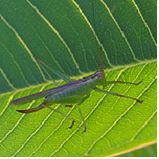
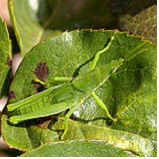
Life Cycle
These insects have a Hemimetabolous life cycle, ie. When the immature nymphs resemble the adults.
Generally the adult deposits up to 30 eggs (egg pod) in the soil during spring, summer and autumn with up to two or more generations per year. The emerging nymphs are called hoppers and there is five stages before the wing buds emerge developing into an adult. The eggs overwinter in a dormant state underground emerging during spring.
Period of Activity
The adults appear during the warmer months of the year. In the dryer areas outbreaks are less frequent though in areas of high rainfall, the outbreaks occur frequently and may turn to plagues.
Damage Caused
Grasshoppers and Locusts are very destructive, singularly and especially in swarms which can defoliate entire fields of corn. The host plant has large pieces of its leaves eaten, the bark is nibbled and almost any part of the plant attacked.
Susceptible Plants
A wide range of commercial crops including corn, wheat, and vegetables. Ornamental shrubs, trees or weeds are also attacked. Certain species are a major pest problem for agriculture.
Cultural Control
It is difficult to control but in early mornings the insects are slow and may be caught and squashed. In a large garden or farms, allow the chooks to free range around the vegetables. They are persistent consumers of the insect. Plants may be covered with a net to reduce access for the insect.
Biological Control
The adult insect is eaten by many birds, predator bugs, lizards and frogs. This helps control small outbreaks but has little effect on swarms.
Chemical Control
It is difficult to chemically control Grasshoppers and Locusts and must be carried out over a wide area and spraying may not guarantee that the crop is not damaged. Bates or traps may also assist in controlling numbers.
Note
Always read the label for registration details and direction of use prior to application of any chemicals.
PEST
NAME
Termites (General)
Various Species
ORDER
Isoptera
FAMILY
Various
Description of the Pest
There are many species of termite found throughout the world particularly in the tropical regions. There are three species that are a pest of living trees. The Subterranean termite (Coptotermes species), Dampwood termites (Porotermes species) and the Drywood termites (Cryptotermes species) all have a highly developed social structure that includes a king, queen, workers and soldiers.
Adult males and females are winged up to 14mm long and the workers are small, 5mm long, wingless with creamy white bodies, commonly known as' White Ants'. Although they are referred to as white ants there body is not constricted between the thorax and abdomen as in true ants and are totally unrelated.
The workers have well developed mandibles for chewing. They are also blind and consist of about 80% of the colonies numbers. Soldiers are also blind, sterile and have very large jaws to protect the colony from invaders. There numbers consist of 3% of the colony and commonly have a pointed dark head.
The Subterranean Termite (Coptotermes lacteus) and (Coptotermes brunneus) which is only found in Western Australia are the most destructive. They form colonies normally under ground or in trees with subterranean tunnels that radiate out up to 50m from the nest, feeding only on dead wood such as posts, fallen branches or roots. This mound forming insect requires constant moisture that is collects from the soil and the tunnels average 200mm below the soil surface.
Appearance and Distribution of the Pest
Termites are found throughout the world from tropical to temperate regions. The adult insects are winged, flying to other areas to form new colonies during late spring. Termites are commonly undetected as they feed on the inside of tree trunks or form shelter tubes on vertical faces.
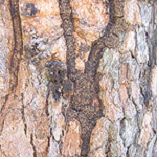 Shelter Tubes
Shelter Tubes
Life Cycle
These insects have a Hemimetabolous life cycle, ie. When the immature nymphs resemble the adults.
Termites have several nymphal stages and adults. Both nymphs and adults have chewing mouth parts.
Male and female fly to a new site in late spring, where there membranous wings fall away from the body. They then mate and produce a small number of eggs, about thirty. After the eggs hatch the female develops into the egg laying queen and both nymphs and soldiers tend her requirements.
In time the nest develops and can become large very large, such as an earthen mound up to 7m tall. The termites avoid light and remain within the galleries they have constructed, protected from environmental extremes such as temperature or humidity.
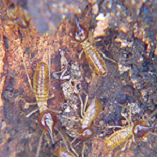 Soldiers
Soldiers
Period of Activity
They are most active during the warmer months of the year.
Damage Caused
The termites form galleries that honeycombing the interior of the host. In the case of trees, branches become structurally weak and break off after the termites enter through the roots or bark. They then eat there way through the heartwood up into the branches. Certain species of termite can also ringbark young trees, and large trees that are infected with termites eventually die. Other species attack fence posts or buildings causing extensive damage.
Susceptible Plants
A wide range of living or dead trees, shrubs and vines are attacked. Non living structures such as fences, buildings or dead trees are also eaten. Many Eucalyptus species when under stress are infected.
Dendranthema species roots are attacked by termites causing the plant to wilt.
Psidium species (Guava) are attacked by the Subterranean Termite (Reticulitermes flaviceps).
Cultural Control
It is very difficult to control termites and preventative measures are essential. Such as the removal of dead or dieing trees including the roots. All possible food sources should be burnt or removed off site. Nests may also be destroyed when found. have soft fleshy bodies that are easily damaged.
Biological Control
Termites are most vulnerable when in flight where they are attacked by birds, lizards ants or adverse climatic conditions. Animals such as echidnas or bandicoots destroy forage lines or entire nests, seeking there soft fleshy bodies.
Chemical Control
It is important to identify the particular species of termite before applying chemicals as this may vary. A trained pest controller should be contacted in order to carry out the best possible method of control.
Note
Always read the label for registration details and direction of use prior to application of any chemicals.
PEST
NAME
Mites (General)
Various Species
ORDER
Acarina
FAMILY
Aleyrodidae
Description of the Pest
Generally mites attack the plant by sucking the sap from leaves and in some cases cause galls on the leaf surface or in the flower and on the fruit. The Adult body is composed of two parts, a head-thorax combination and an abdomen, both fused together to appear as a single segment. The size varies but generally they are small pear-shaped animals that are 1mm or less and have no antennae or wings.
The females have eight legs and vary in colour depending on the host plant and the nymphs are six-legged, with another pair of legs appearing as the mite matures. Males are generally smaller and fully-grown adults of some species are visible to the naked eye.
Bulb Mite (Rhizoglyphus echinopus). This is a slow moving yellowish-white mite may be visible to the naked eye and infests bulbs or corms in the soil. When lifted under warm humid conditions of 16ºC (61ºF) and above the mites are most active causing bulbs to deteriorate quickly. Under cool conditions the mites may go undetected and when replanted they cause the leaves to turn yellow and the flower to blight. On inspection of the bulb the scales are hard with a brownish colour and the dried pulp will be infested with hundreds of active mites. This damage allows the entry of other fungal or bacterial rots to occur.
Eucalyptus Blister Gall is a rough textured gall that appears on the leaf surface as a pale coloured raised area and may be blotched with red. The tiny mites that cause this damage feed breed and live within the gall causing extensive disfiguring of the leaves in certain tree species. There are a variety of species that attack such as Eriophyid mite and occur from tropical to temperate regions and normally found on Eucalyptus.
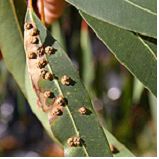
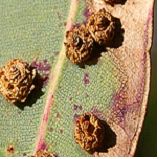
Appearance and Distribution of the Pest
Found world-wide with over 30,000 species. They congregate in protected places, such as under bark and at the base of trees, during winter.
Life Cycle
Mites have a gradual metamorphosis, with several nymphal stages. Each female lays up to 100 eggs that hatch in 7-14 days, with several generations appearing throughout the year. Females may become inactive during cold weather.
Period of Activity
Mites are most active during the warmer months of the year, preferring drier periods.
Damage Caused
Normally Gall Mites do not cause significant damage although they may interfere with flower and fruit production. Certain species such as Banksia integrifolia are more susceptible than other plants.
Susceptible Plants
A wide range of plants are attacked by Mites including annuals, fruit trees and vegetables, ornamental shrubs and trees.
Banksia integrifolia is attacked by the Banksia Mite Gall which disfigures developing fruit, reducing the quantity of seed produced.
 Banksia integrifolia
Banksia integrifolia
Sorbus aucuparia is attacked by the Pear Leaf Blister Mite (Eriophyes pyri) infests leaves causing blisters on the underside of the leaf and eventual defoliating of the tree.
Tulipa and Crocus species are attacked by Bulb Mite (Rhizoglyphus echinopus) causing the bulbs or corms to deteriorate.
Note
Many plant species are more susceptible to Red Spider Mite when they are cultivated under glass.
Cultural Control
Heavy rain or irrigation can reduce numbers as will frequent overhead watering; some plants may benefit from replanting in cooler locations. Generally, however, infested material should be completely removed and destroyed. Preventive measures include weed control and removal and destruction of plant material that is infested. Galls that appear on plants should be removed to reduce population build up and plants that are repetitively attacked should be replaced with less susceptible species.
Plants that are infected with Bulb Mite can have the bulbs or corms (before they develop roots) dipped into hot water for a few minutes to eradicate the pest. Soil that is infested needs to be steam-pasteurised prior to replanting.
Biological Control
Natural predators include lacewings, ladybirds and thrips; insecticide-resistant predatory mites are also available commercially to control the Two-spotted Mite such as Phytoseiulus persimilis.
Chemical Control
Dimethoate will reduce numbers; however, mites become resistant to insecticides. Dusting with wettable sulphur may also prove effective.
PEST
NAME
Winter Bronzing
Thaumastocoris species
ORDER
Hemiptera
Description of the Pest
Thaumastocorids bugs are sap sucking insects with a strong proboscis and are shield shape. The adult is dull brown with long anatine and legs, growing to 5mm long. The ovoid black eggs are microscopic size 1mm in length and in time the egg colour remains black unlike Psyllids eggs that fade. They are laid in groups from 60 to 1,000 on the leaves in clusters up to a 10mm wide. They feed in colonies and cause excessive damage. Both adults and nymphs have piecing and sucking mouthparts and adults commonly shelter under leaves or bark during winter.
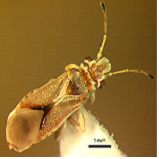
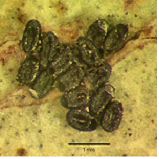
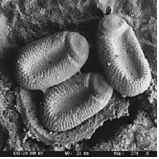 Eggs mag. 274 x
Eggs mag. 274 x
Image by A. Noack
Appearance and Distribution of the Pest
Generally nymphs appear in early winter to winter after hatching from eggs that were laid in late autumn, but the pest may be seen through the year in extreme cases. The adults can fly short distances or further with the assistance of wind, to a new host plant to distribute eggs or feed. This is not a wide spread problem, but an important one in urban areas of Sydney Australia. Other species are found in Tasmania and Western Australia. Colonies of this insect have been recorded in South Africa and are thought to be originating from Australia.
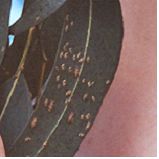 Active insect on leaf
Active insect on leaf
Life Cycle
These insects have a Hemimetabolous life cycle, ie. When the immature nymphs resemble the adults.
The black eggs hatch within two weeks and there are five nymphal stages before reaching an adult. The origin of the pest is unknown and it has only recently become a pest.
Damage Caused
The sap sucking activities greatly reduces the capability of the leaf to photosynthesise by feeding on the epidermal layer of the leaves. These leaves are then shed, and the repetitive attack on a tree weakens its ability to produce food (starch). Branches and twigs die back and eventually the tree starves to death. Initial symptoms are pale green foliage that turns reddish or bronze. This colour change occurs quickly over a 5 day period and infestations normally occur on a small part of the crown at first. The insects do not produce honeydew
White Stemmed Gum Moth and Winter Bronzing.
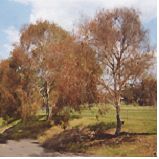
Image by A. Noack
Susceptible Plants
Eucalyptus species are the host with certain species most susceptible, such as Eucalyptus nicholii (Narrow Leafed Black Peppermint).
Other species are less severely attacked these include, Eucalyptus bicostata (Southern Blue Gum), Eucalyptus tereticornis (Forest Red Gum), Eucalyptus viminalis (Ribbon Gum), Eucalyptus camaldulensis (River Red Gum), Eucalyptus microcorys (Tallow Wood), Eucalyptus sideroxylon (Mugga Iron Bark) and Corymbia citriodora (Lemon Scented Gum).
Cultural Control
It is very difficult to control this pest using cultural methods, but infested trees can be watered and feed to improve vigour.
Biological Control
There is no satisfactory biological control but the Mymarid wasp deposits her eggs in up to 30 Thaumastocorids eggs at a ratio of 1 to 1.
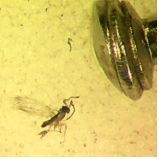 Mymarid wasp next to pin head
Mymarid wasp next to pin head
Chemical Control
There is no long term solution to infestations, but trees may be injected in extreme cases.
Note
Always read the label for registration details and direction of use prior to application of any chemicals.
PEST
NAME
Case Moths, Bag moths
Various Case Moth
Species
ORDER
Lepidoptera
FAMILY
Psychidae
Description of the Pest
Also called the bag moth or bagworm - so called because of the silken, bag or case-like structure in which they shelter and pupate. The pendant case is frequently covered with twigs, pine needles, sand or leaf fragments, which serve to reinforce and camouflage it. The case is enlarged as the caterpillar grows and the upper part of the body emerges for feeding and movement. It withdraws into the case if threatened or disturbed.
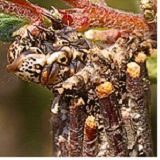 Case moth feeding
Case moth feeding
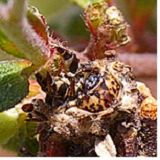 The head protrudes from the case to feed
The head protrudes from the case to feed
Leaf Case Moth (Hyalarcta huebneri) constructs a short cocoon that has a ragged appearance and is covered in leaf and bark pieces. The caterpillar is orange with black bands and can grow to 50mm (2in) long. This pest can be found on Eucalyptus and Leptospermum species, it may also attack palms from sub tropical to tropical regions.
Ribbed Case Moth (Hyalarcta nigrescensi) forms a greyish cocoon that has four prominent ribs and taper at the base. It feeds solitary on Acacia and Eucalyptus species by chewing on the leaves or removing the epidermal layer of the leaf.
Saunders Case Moth (Metura elongatus) forms an elongated silken bag composed of small pieces of twig and is up to 150mm (6in) long. The caterpillar is dark red with yellowish bands and markings. It is commonly seen from temperate to tropical regions feeding on leaves of Eucalyptus, Callistemon and Epacris species. When disturbed it hides in its cocoon and control is not normally required.
 Saunders Case Moth
Saunders Case Moth
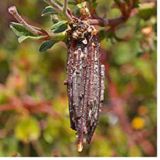 Ribbed Case Moth
Ribbed Case Moth
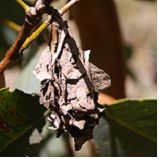 Leaf Case Moth
Leaf Case Moth
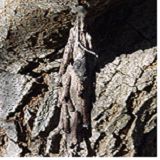 Well Camouflaged
Well Camouflaged
Life Cycle
This insect has a Holometabolous life cycle, i.e. it has a larval and a pupal stage.
The larval stage can last up to 2 years.
The male moths can fly. In some species the females are wingless, or have greatly reduced wings.
In some species the females can lay over 10,000 eggs.
Larvae pupate in their cases. Newly hatched larvae disperse and construct their own cases.
Distribution of the Pest
They are widespread across most temperate to tropical Australia.
Damage Caused
Larvae eat leaves and on masse they may cause considerable damage.
Larvae and their cases are difficult to detect among foliage.
Period of Activity
Larvae are more numerous and active during the warmer months.
Susceptible Plants
A wide range of plants are susceptible to case moth larvae, with different moth species favouring different plants. Host plants include eucalypts, acacias, pines and conifers.
Callitris species are attacked by the Stick Case Moth (Clania ignobilis) that constructs a cylindrical cocoon of aligned twigs with a projecting twig at the base and feeds on small or young foliage. It is not a major pest causing little harm.
Larix species are attacked by the Larch Casebearer (Coleophora laricella). The caterpillar forms a cigar-shaped case from pieces of needles. It feeds on the needles in late spring by forming a hole either end or the middle of the leaves and mining the centre with out leaving its case. It then overwinters in its case attached to the twigs and the moth emerges in early summer.
Control
Cultural Control
Early detection and control of infestation is important with some species; they may be removed by hand.
Biological Control
Birds are natural predators.
Chemical Control is possible, but this is not usually necessary.
Note
It is your responsibility by law to read & follow the directions on the label of any pesticide
Amendments by B. Sonsie Dip Hort Sc Burnley
PEST
NAME
Ants (General)
Various Species
ORDER
Hymenoptera
FAMILY
Formicidae
Description of the Pest
Ants are socially organized, living in colonies that can be found underground, in logs or in ant hills. Ant colonies normally consist of three castes, female, male and sterile workers. The queen lays eggs and is winged until it mates. The males are winged and seek females to mate with. A colony may have only one queen, or there may be many queens depending on the species. Ants are easily recognised by a swollen node at the end of a long narrow waist, (waist) or by there elbowed antennae. Ants may also have more than one nest and workers form trails or tunnels, over some distance to service the colonies. Many species of ants have poison sacks &/or stingers in for defence against their many predators. Ants vary in length from about 1 to 30 mm & are typically black, brown, red, yellow or a combination of these colours.

 Elbowed antennae
Elbowed antennae
Note
There are many species of ants and it should be recognised that ants can be beneficial as well as a pest. There are only a few species that damage plants or turf.

 Ant Jaws
Ant Jaws
Red Bulldog Ant (Myrmecia gulosa) is large and primitive, having a less complicated social organization. They are also fighters (pugnacious) and have large mandibles that can bite causing a painful sting.
 Winged Queen
Winged Queen
 Queen Golden Spiny Ant
Queen Golden Spiny Ant
Golden Spiny Ant (Polyrachis ammon) is a medium size insect with a black body and marked with a bright golden patch on the back of the thorax and abdomen. They also have four spines on the thorax and node.
Argentine Ant (Linepithema humile) is a tiny brown ant to 3mm long and has become a pest in many areas feeding on a variety of materials and is easily recognised as it travels along defined trails.
Black-headed Sugar Ant (Camponotus nigroceps) is a large ant with a reddish thorax and legs and a black head. The queen is winged and its bite has no sting.
Honey Pot Ant (Camponotus inflin) is small and some workers are stuffed with food until they cannot move and are used as a living food container.
Life Cycle
Ants have a complete metamorphosis (Holometabolous egg, larva, pupa and adult). The queen remains in a chamber and deposits eggs, nests may have more than one queen. The legless lava emerges and is feed by workers until they enter the pupal stage. After pupating they become worker ants, males or future queens. Workers tend to the colonies needs, such as constructing tunnels, collecting food, looking after the queen and eggs. They also defend the nest.
Ants overwinter in all stages of the life cycle in there nest.
Distribution of the Pest
Ant activity is found throughout the year in tropical regions but is more active during the warmer months in temperate regions. They are distributed by the adults flying to new areas to form colonies and are transported in infested pots or other materials such as turf sods.
Period of Activity
All year
Damage Caused
Ants cause plant damage in several ways, such as chewing on leaf margins causing minor damage or collecting and destroying seeds. Ants have formed many associations with insects which produce honey dew such as Aphids, leaf hoppers and some scales and lerps, and can interfere with biological controls.
Ants are predators of many insects and larvae such as caterpillars. A balance is required depending on the species of the plant under attack and in the garden ants should be left alone.
 Ants tending Lerps
Ants tending Lerps
 Ants tending Mealybugs
Ants tending Mealybugs
Potted plants commonly have nests established in the base of the pot and disrupt water saturation of the soil.
Funnel Ants (Aphaenogaster species) cause turf grass to die by removing the soil around the roots and creating mounds above soil level. These nests restrict the available water to the roots and have a simular affect as a drought.
Fire Ants (Solenopsis invicta) are a serious pest of agriculture and horticulture as they attack and sting repetitively after being disturbed creating problems for people in the field.
Susceptible Plants
There is a wide range of ornamental plants such as Wattles that become infested with ants and are associated with insects that produce honey dew.
Container plants or indoor plants are commonly infested resulting in a decline of vigour.
Samanea saman is attacked by (Myrmelachista ramulorum), an ant that defoliates and deforms leaves by burrowing into the twigs.
 Ants on Eucalyptus species
Ants on Eucalyptus species
 Ants eating insect
Ants eating insect
Control
Cultural Control
Young or sensitive trees may be banded with sticky traps, glue or grease to inhibit the access of ants tending other sap sucking insects and allowing natural predators such as ladybirds to control insect infestations. Weed control under trees or the removal of debris and food scraps also reduces ant infestations. Container plants can be emersed in water to rid them of ants.
Biological
Ants are an important component of the ecosystem and although a wide range of animals feed on ants none are commercially available.
Chemical Control
There are various chemical methods to deter ants, such as poring turps into the nest or spraying a mixture of kerosene and detergent around the nest. Ants may also be sprayed with a contact insecticide.
Baits can be used to control ants
Note
It is your responsibility by law to read and follow the directions of any pesticide
Monitoring
Pitfall traps
Amendments by B. Sonsie Dip Hort Sc Burnley
PEST
NAME
Spittle Bugs, Cuckoo Various Species
ORDER
Hemiptera
Description of the Pest
Generally Cuckoo spit bugs are small beetle-like or cicada shaped insects up to 10mm long and have soft greyish bodies. They produce a frothy secretion that covers the young for protection and stops them from drying out. Both adult and nymph have piercing sucking mouth parts. The adults are capable of jumping when disturbed and are commonly known as 'froghoppers'.
Common Cuckoo Spit (Philagra parva) is brown and small up to 4mm long with a pointed head. The soft nymphs are brown and produce white froth.


Cuckoo Spit (Bathylus albicinctus) are a small brown beetle-like insect up to 5mm long and has larvae that cover themselves in white froth.
Appearance and Distribution of the Pest
They are found during the warmer months in temperate climates and throughout the year in sub-tropical to tropical regions. They spread by flying.
Life Cycle
These insects have a Hemimetabolous life cycle, ie. When the immature nymphs resemble the adults.
Damage Caused
The insects feed off the plant and are found in the leaf axils, normally not affecting the plant.
Susceptible Plants
There is a wide range of plant attacked by this insect including Casuarina, Acacia, Grevillea and Baeckea species.
Cultural Control
The insects may be hosed off but generally control is not required.
Biological Control
Birds and other predators keep the numbers down.
Chemical Control
Not normally necessary.
DISEASE
NAME
Armillaria Root Rot, Honey Fungi
Armillaria luteobubalina
Description
This naturally occurring fungus grows between the bark and wood of trees producing distinctive cream sheets of hyphae. The toadstool-like fruiting bodies are yellowish brown and appear from the soil or sprout out of the base of the host plant.

Image by Dr Brett Summerell
Symptoms
This is a vigorous fungus that attacks the roots of trees and is not normally noticed until dieback starts to occur. Affected plants generally appear declined, with some dieback and by this stage; the disease may be well established. Leaves can turn yellow, shrivel and fall from the plant and the branches die back. Citrus trees may produce a heavy crop of fruit just before death. Splits often occur on the trunk of affected trees and the bark may lift revealing white sheets of mycelium or hyphae under the bark. These hyphae will have a distinctive "mushroom" smell. Affected roots become spongy, powdery or jelly-like and when dissected reveal similar white sheaths under the bark. Infected plants may survive for many years before final death of the tree.
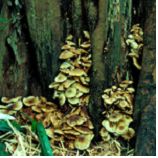
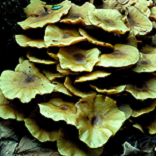
Image by Dr Brett Summerell
Source and Dispersal
This fungus is a native species that is naturally found in Eucalyptus forests and woodlands throughout eastern Australia and south-western Australia. It is commonly found on old tree trunks and decaying wood where honey coloured toadstools appear from the base of the host or surrounding soil in May-June. The toadstools produce white spores that are dispersed by wind, but generally the fungus spreads underground through contact between infected and uninfected roots. The fungus can grow about 1-1.5 metres per year along a root. This species, unlike those in the northern hemisphere does not produce rhizomorphs, thick strands that are flat resembling shoe-strings.
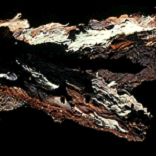 Mycelium on wood
Mycelium on wood
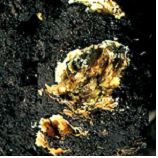
Image by Dr Brett Summerell
The fungus is not spread by contaminated soil as it only grows in root material. Spread to new sites is either through spore movement (very rare), movement of infected plants or through movement of contaminated wood chip used for mulch. Dead or dying trees should be inspected for the presence of this pathogen prior to use as mulch.
This fungus can survive for many years in infested root and stem material depending on the size of the material and speed of decomposition of the wood.
Favoured Conditions
This fungus prefers sandy soil types and is more frequently found in more freely drained soils. Moisture is required for growth of the fungus along the root system. Generally the damage caused to plants is greater on plants that are already under stress or weakened. The retention of infested root systems and stumps in the soil has contributed to an increase in the occurrence of this disease.
Affected Plants
The host range for this fungus is extremely wide and includes many ornamentals and Australian native plants. Fruit trees and perennials are also commonly attacked. The most susceptible species include oaks, camellias, azaleas, roses and eucalypts.
Amaryllis, Narcissus and Hippeastrum species are also infected.
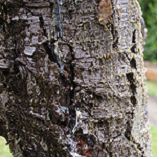 Cedrus species trunk
Cedrus species trunk
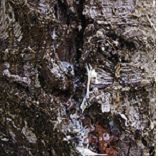
Image by Dr Brett Summerell
Cedrus species are also affected by Armillaria root rot causing the roots to rot and the trunk to swell and spilt open. There is no control for these infections.
Non-chemical Control
Control of this disease is totally dependent on removal of the inoculum of the fungus from the soil. To be effective this will require removal of the infested roots and stem, a process that may be difficult in garden beds. Infected plants should be removed and disposed of, but it is not necessary to remove the surrounding soil as the fungus only occurs in the plant. When clearing affected land for cultivation, remove all stumps and roots and allow 2 to 3 years prior to replanting.
Trees that are in the early stages of attack may be saved by removal of the affected roots and leaving remaining roots exposed for several years. Top soil around the trunk should also be removed for a distance of up to 1m and affected trees should be fertilised and watered to encourage vigour.
Chemical Control
There is no practical or effective chemical control. Fumigation has been carried out to eradicate the fungus but success is dependent on the removal of large sources of inoculum. However many of the chemicals used for this purpose are highly toxic and have restricted usage now.
Note
Always read the label for registration details and direction of use prior to application of any chemicals.
Amendments by
Dr Brett Summerell
Director Science and Public Programs
Royal Botanic Gardens Trust, Sydney
DISEASE
NAME
Eucalyptus Shoot Blight
Quambalaria pitereka
Description
A fungal problem that attacks some Eucalyptus and Corymbia species.

Symptoms
Young shoots and leaves are attacked causing them to become distorted and have an appearance of being spatted with white paint. This is caused by sporulation of the fungus and it progresses from the leaves to the stems causing splitting of the bark. Infected leaves fall prematurely and dieback occurs in the stems. The overall effect is a sparsely foliaged tree with heavily distorted shoot tips.
Source and Dispersal
It is found on other infected trees and is dispersed by wind, rain or infected nursery stock and contaminated leaves or branches. Once a tree is infected it moves rapidly throughout the plant.
Favoured Conditions
It prefers humid still conditions with warm temperatures and is particularly a problem in tropical areas. It has been recorded in many areas of New South Wales and Queensland, especially in coastal and highland areas.
Affected Plants
Eucalyptus, Corymbia and Angophora species such as C. citriodora, C. maculata and Angophora costata are infected and repetitive attack stunts or can in rare cases kill the tree.
Non-chemical Control
On small trees remove and destroy the infected parts or in a nursery remove and destroy infected stock.
Chemical Control
Plants may be sprayed at five day intervals with copper oxychloride if possible.
Note
Always read the label for registration details and direction of use prior to application of any chemicals.
DISEASE
NAME
Rust (General)
Various Rust Species
Description
Generally this fungal problem involves many species causing a range of symptoms, but generally produces pustules that release reddish - brown spores. Most fungus is specific to its host and normally will not infect other plant species.
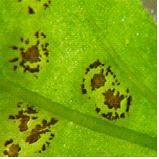 Pustules
Pustules
Symptoms
The upper leaf surface develops red, brown or yellow areas and the underside produces bright yellow to orange spores that correspond to the patches above. Infested leaves become brown in patches, fall prematurely and flower and fruit may also be infected. This overall, results in a loss of vigour and in small plants may lead to death.
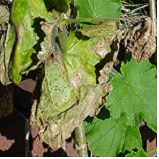 Pelargonium x hortorum
Pelargonium x hortorum
Myrtle Rust (Puccinia psidii) This fungal disease infects plants in the Myrtaceae family and was only recently detected in 2010 and has since spread across eastern Australia from the Northern Territory to Queensland, NSW, Victoria and Tasmania. This rust attacks soft and actively growing foliage or shoots with varying symptoms. It normally starts as small purple spots on the leaves from which spores form in yellow pustules that fade to grey as the infection matures and can merge creating leaf distortion and death of the plant.
The life cycle starts when the powdery yellow spores are distributed by wind to other plants where they germinate and start to grow by piercing the plant cells to obtain nutrients. Germination occurs in dark moist positions with a temperature between 15° to 25°C and the new pustules can release spores in 10 to 12 days, (spores remain viable for 3-months). The spores spread rapidly by wind, water, insects or animals. They are also distributed by plant material, clothing, shoes and vehicles.
 Puccinia psidii
Puccinia psidii
Needle Rust (Melampsora farlowii) infects the new leaves turning them to yellow and fall from the shoot giving the branch a scorched appearance. The fruiting bodies are found on the underside of the leaf and is waxy-red.
Rust in Poplar (Melampsora species). A fungal problem involving at least two species (Melampsora medusae) and (Melampsora larici-idaei).
The upper leaf surface becomes flecked with yellow to light green and the underside produces bright yellow orange spores that correspond to the patches above. Infested leaves become brown in patches, fall prematurely and shoots may die back as a result of not being hardened off to the elements. This overall, results in a loss of vigour and in small plants may lead to death.
The source of the fungus is from other infected plants or fallen leaves and is dispersed by wind.
Host plants include Lombardy Poplars particularly Populus nigra 'Italica' and cottonwoods.
White Rust (Albugo candida) forms snow white pustules that contain colourless spores that turn yellow then brown and are found on the underside of leaves.
White Pine Blister Rust (WPBR) is caused by the fungus (Cronartium ribicola). It is a obligate parasite requiring a living host to survive. The life cycle requires two host species with part of it life on the Pinus species and the other part on Ribes species. First cankers or sores appear on the Pinus species realising spores that land on the Ribes species infecting it. The infection produces a different type of spore that land on the needles and growing branches of the Pinus species and eventually forming cankers. The spores are spread by wind and prefer cool moist conditions. Symptoms include brown spots on the needles and the appearance of dead branches in the crown. Cankers will also appear on the trunk and it tends to attack young trees. Control methods include removal of Ribus species in the affected areas and breading naturally resistant Pinus species.
The Rust (Endophyllum sempervivi) affects Sempervivum species by infecting the young leaves and eventually the crown. The mycelium then travels to the roots and extends into any off shots. Leaves that are infected turn yellowish, grow longer and are thin. Persistent infection may kill the plant.
Source and Dispersal
The source of the fungus is from other infected plants or fallen leaves that contain the fruiting bodies and is dispersed by wind.
Favoured Conditions
Generally rust is more prevalent during summer, preferring warm humid conditions and particularly when the leaves are damp.
Affected Plants
A wide range of ornamental annuals, perennials, ferns, trees, shrubs including, Hibiscus species that are infected by Kuehneola malvicola predominantly in southern USA.
Abies species are infected by many types of rust including (Milesia fructuosa) and (Uredinopsis mirabilis).
Abutilon, Phymosia and Alcea species are infected by the rust (Puccinia heterospora).
Alnus species are occasionally infected with Leaf Rust (Melampsoridium hiratsukanum) which forms yellowish pustules on the leaves that develop turning the leaf brown.
Amelanchler species and Calocedrus decurrens are infected by several rust species including (Gymnosporangium libocedri).
Antirrhinum majus (Snapdragon) is infected by the rust (Puccinia antirrhini). This fungal problem that infects the epidermal layer on the leaf underside, forming pale green areas that are raised and split open revealing reddish brown spores that have a dusty appearance.
As the infestation grows, concentric rings of spore pustules appear around the original infection. The corresponding position on the upper leafs surface turns yellow eventually causing the leaf to wilt and die. The infestation is not restricted to the leaves; all above ground parts of the plant are susceptible and infected plants transmit the fungus dispersing it by wind.
Infected plants should be removed and destroyed.
Anemone and Prunus species are infected by the rust (Tranzschelia pruni-spinosae) that stimulates abnormal growth in the plant during spring.
Aquilegia, Anemone, Delphinium and Clematis species are infected by the Rust (Puccinia rubigo-vera var. agropyri).
Arctostaphylos manzanita is infected by the rust (Pucciniastrum sparsum) occurring in coastal regions but is not normally detrimental to the plant.
Artemisia species are infected by the rust (Uromyces ari-triphylli) which is a systemic disease that is transmitted through seeds. It causes the leaves to turn yellow then die and can infect all parts of the plant except the roots.
Bambusa species are infected by the rust (Dasturella divina) which forms elongated brownish strips on the leaves.
Berberis species may be infected by the Rust (Puccinia graminis) that forms orange spotting on the leaves. It certain regions plants infected with this rust must be removed and destroyed to avoid infecting neighbouring agriculture crops.
Betula species may be infected by Leaf Rust (Melampsoridium betulinum) that forms reddish-yellow spots on the leaves and heavy infestation can defoliate the tree. The host tree changes to Pseudolarix species during the sexual stage and causes blistering of the leaves.
Calendula species may be infected by the Rust (Puccinia flaveriae).
Callistephus and Solidago species may be infected by the Rust (Coleosporium solidaginis) which forms bright yellow spots particularly on new foliage or young plants.
Canna species may be infected by the rust (Puccinia Thaliae).
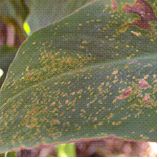
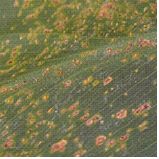 Canna indica
Canna indica
Centaurea species are infected by the rust (Puccinia cyani) and (Puccinia irrequisita) which can cover the stems and leaves.
Cleome species are infected by the rust (Puccinia aristidae) but rarely requires control.
Dianthus species are infected by the rust (Uromyces dianthi) which forms powdery brown spots that appear on both sides of the leaves. The leaves curl and die and the plant becomes stunted. This is a common problem that occurs when grown in a protected enclosure (hot house).
Ficus species are infected by the rust (Cerotelium fici) which forms small brown spots, and causes the leaves to turn yellow then fall prematurely.
Fuchsia species are infected with (Pucciniastrum epilobii). This fungus caused purplish red blotches on the upper leaf surface, that become dry in the middle and result in a brown patch with purple edges. On the underside of the leaf, corresponding to the patches, yellow orange spores form. Heavily infected leaves become yellow and drop prematurely. This leads to a loss of vigour in the plant and infected plants transmit the fungus.
Certain cultivars are more susceptible than others, particularly 'Orange Drops' and 'Novella'.
Hydrangea species is infected by (Pucciniastrum hydrangeae) causing yellowish brown pustules to appear on both sides of the leaf. The leaf becomes dry and brittle.
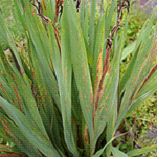
 Iris species
Iris species
Iris and Dietes species are very susceptible to the rust (Puccinia iridis). Leaves form rusty red powdery spots that enlarge. They are appear on both sides of the leaves causing the surrounding area to turn pale yellow then brown and the black spores appear soon after, overwintering on dead infected leaves. Plants may be heavily infected but normally survive attack.
Larix species are infected by several Needle Rusts including (Melampsora paradoxa), (Melampsora medusae) and (Melampsoridium betulinum). The fungi attacks the needles predominantly towards the branch tips turning them yellow and eventually killing them . The underside of the leaf develops pale yellow fruiting bodies.
Lupinus species are infected by three species of rust including (Puccinia andropogonis var onobrychidis).
Malus andChaenomeles species may be infected by the rust (Gymnosporangium juniperi-virginianae) or (Gymnosporangium clavipes) which forms brown or bright orange spots on the leaves or twigs and can defoliate the tree. Juniperus virginiana and Mespilus germanica may also be infected by rust.
Mathiola and Arabis species are infected by White Rust.
Pinus species are infects by the Comandra Blister-rust (Cronartium comandre).

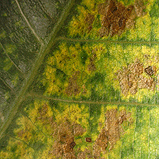
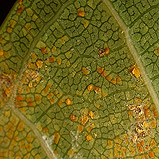
Plumeria rubra Leaf upper surface Leaf underside
Plumeria species are susceptible to the rust (Coleosporium plumeriae). Leaves and flowers may be infected with the underside forming bright yellow pustules and causes premature leaf or flower drop.
Populus nigra 'Italica' is infected by the rust (Melampsora species) which forms pustules to form on the leaves turning them brown and causing premature leaf drop.
Rhododendron and Tsuga species are infected by the rust (Pucciniastrum vaccinii) and is commonly found in nursery stock, spreading rapidly. Tsuga species are also infected by Needle Rust.
Ribes species are infected by the rust (Cronartium ribicola). This leaf rust appears on the underside of the leaves (preferably older leaves) forming dusty brown pustules and is a serious problem. This rust only appears when White Pine (Pinus strobes) grows near where the alternate stage of the fungus occurs.
Rudbeckia species are infected by several species of rust including (Puccinia dioicae) and (Uromyces rudbeckiae).
Salix species are infected by four types of (Melampsora species).
Senecio, Bellis and Calendula species are infected by the rust (Puccinia lagenophora) which forms blister-like pustules that release brown spores.
Sorbus aucuparia is affected by several rust from the (Gymnosporangium species) causing circular yellow spots, that appear on the leaves during summer and develop into orange cup-shaped fruiting bodies.
Trillium species are infected by the rust (Uromyces halstedii) that damages the leaf surface.
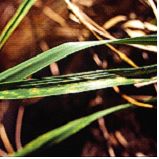 Festuca arundinacea
Festuca arundinacea  Rust
Rust
Turf Grass are susceptible to rust (Puccinia species) and (Uromyces species), causing yellow flecks to appear on the stems and leaves. These markings enlarge before the pustules form and in severs cases the lawn has a yellow, red or brown appearance.
The infection appears from spring to summer under humid low light conditions and turf that is under stress or with excessive nitrogen in the soil is more susceptible. Many species may be infected including Lolium perenne (Perennial Ryegrass) and Poa pratensis (Kentucky Bluegrass).
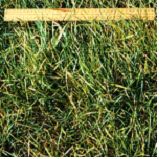
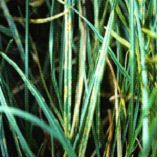 Rust on Perennial Ryegrass
Rust on Perennial Ryegrass
Viburnum species are mildly affected by two types of rust (Coleosporium viburni) and (Puccinia linkii).
Viola species are infected by the rust (Puccinia violae) which forms green spots on the underside of the leaves. It is not commonly seen on cultivated plants.
Non-chemical Control
Cut off and destroy any infected branches, fallen leaves and remove heavily infected plants. Improve the culture by, pruning to improve air circulation, allow space between plants and avoid over crowding. Avoid planting susceptible species. Plants that are infected with a systemic form should be removed and destroyed
Chemical Control
Not possible to spray large trees but young plants may be treated with a protectant fungicide such as wettable sulphur. In a domestic garden small plants such as Fuchsia species may be sprayed with a protectant chemicals as symptoms appear, aided by the removal of existing infected leaves. Under commercial conditions stock may be sprayed with a fungicide such as oxycarboxin.
Note
Always read the label for registration details and direction of use prior to application of any chemicals.
Average Lowest Temperature : -3º C 27º F
USDA : 7, 8, 9, 10, 11
This USDA (United States Department of Agriculture) hardiness zone chart can be used to indicate a plant’s ability to withstand average minimum temperatures. However, other factors such as soil type, pH, and moisture, drainage, humidity and exposure to sun and wind will also have a direct effect on your plant’s survival. Use this chart only as a guide, always keep the other factors in mind when deciding where, when and what to plant.
A plant's individual USDA zone can be found in the Plant Overview.
Region of origin
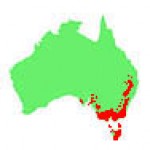
Australia (south-eastern New South Wales, Victoria, Tasmania, King Island, Flinders Island)
Climate Description
Warm Temperate
This zone has the majority of rain during winter in the west and summer in the east with high humidity. Summer temperatures may peak at 40ºC (104ºF).
Frost and drought mainly occur inland and coastal wind is normally accompanied with rain.
Plant growth
Wide range of native and exotic plants grow well.
| Dictionary | Growth Habit |
| Leaf Type | Botanic Flower Description |
| Leaf Shape | Flower Inflorescence |
| Leaf Arrangement | Fruit Type |
| Leaf Margin | Bark Type |
| Leaf Apex And Bases | Flower Description |